October 2024 News
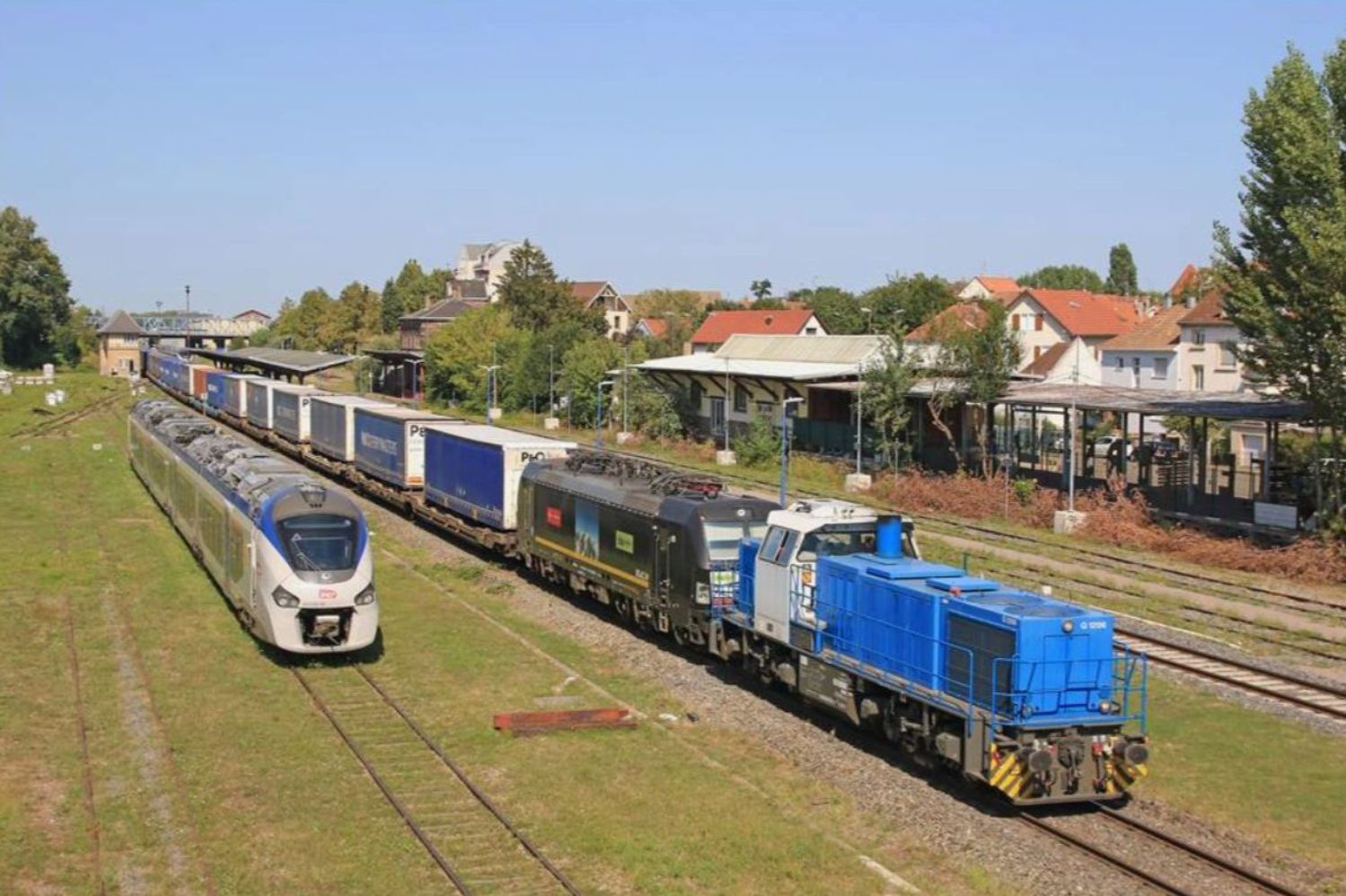
During the last three weeks of August, bridge work on the Rheintalbahn in Germany saw 37 daily freight trains diverted over the unelectrified line between Wörth, Lauterbourg and Strasbourg (see September News) before rejoining the Rheintalbahn at Offenbach. On 27th August a Captrain G1206 is seen passing through Bischheim dragging two intermodal trains with Crossrail and BLS Cargo Siemens Vectrons. Photo: Christophe Masse.
The successful diversion was the culmination of three years’ planning by SBB Cargo International, Captrain France, DB InfraGo and SNCF Réseau. Capacity of the Lauterbourg route was stretched to its limit, leading to calls for lines through Eastern France to be upgraded to provide a high-capacity alternative route to that through Germany. This would avoid stagnation in the growth of intermodal traffic and enable freight to continue flowing during the engineering blockades planned to take place through to 2030. Upgrading Metz – Strasbourg – Basel for 4m clearance would provide extra capacity and reduce the distance for Alpine traffic from Belgium and southern Netherlands by 110 km.
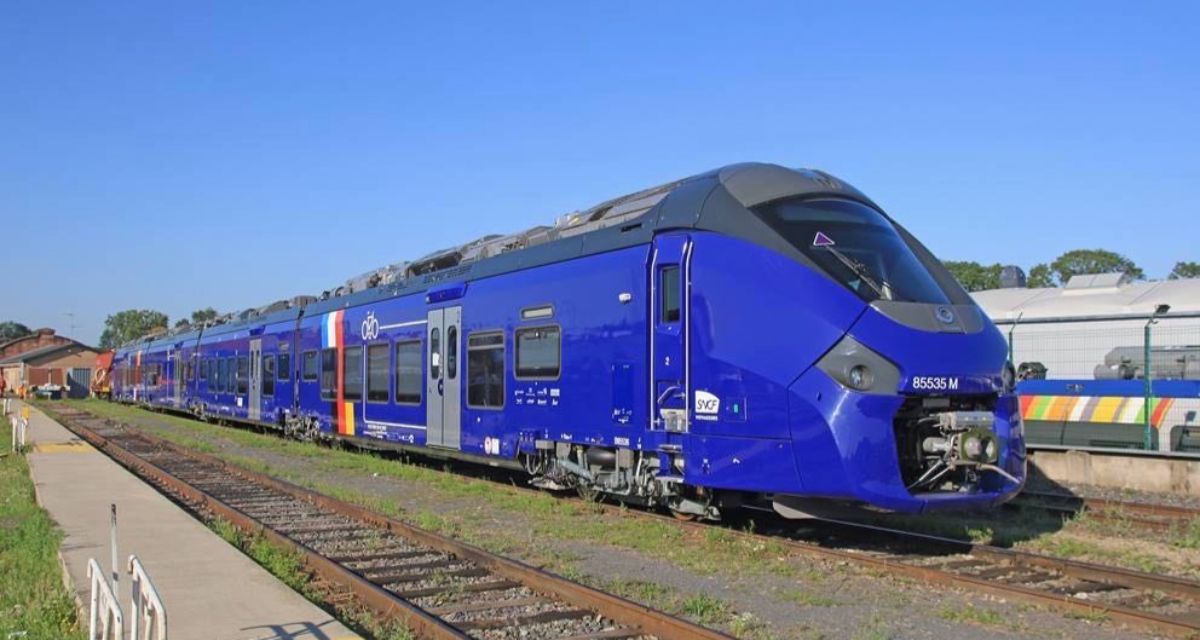
Grand Est cross-border EMUs
The first of 30 Coradia Polyvalent B 85500 Régiolis four-car EMUs designed for cross-border operation was unveiled by Grand Est at Bischheim on 27th August. Once the trains are cleared for operation in both countries and an operator selected, they will provide through services on seven routes totalling 450km: Thionville – Apach – Trier, Metz – Forbach – Saarbrücken, Strasbourg – Sarreguemines – Saarbrücken, Strasbourg – Wissembourg – Neustadt, Strasbourg – Lauterbourg – Wörth – Karlsruhe, Strasbourg – Kehl – Offenburg and Mulhouse – Mülheim. Meanwhile, the first four trains will enter local service in Grand Est this month.
This Régiolis variant is equipped for service at 25kV AC in France and 15kV AC in Germany, with a maximum speed of 160km/h, and will operate under diesel power on non-electrified sections. There is seating for 200, of which 16 are in a first-class saloon, space for 18 cycles and accessible toilets meeting French and German PRM standards. The new services are aimed at the many thousands of daily commuters crossing the border by car. Trains will run with the same crew throughout their journeys in both countries, the intention being to make cross-border trips as seamless as they are by road.
Ordered from Alstom in 2019 at a cost of €388 million, the trains have received funding to the tune of €20 million from the German Länder of Baden-Wurttemberg, Saarland and Rhineland-Palatinate. At the same time, a further nine four- and six-car sets were ordered to expand the Grand Est domestic fleet. All 39 sets will be commissioned by CAF following Alstom’s divestment of the Coradia design and Reichshoffen plant.
Having been presented to the German press at Neustadt as long ago as July 2021, the trains have been in store at Lauterbourg and Reichshoffen pending a decision on who would operate them. While Grand Est had wanted SNCF to run the cross-border routes, the German Länder preferred to seek a concessionaire. The tendering process has not been smooth but may be completed by the beginning of next year, with late-2025 seen as the earliest start date for cross-border operation. Grand Est and the Land of Baden-Württemberg are meanwhile working to automate timetable data, allowing would-be passengers to consult train times and connections in the neighbouring region using an app detailing local services.
Set B 85535/36 seen at Bischheim on 27th August. Photo: Christophe Masse.
CDG Express further delayed
The government has paid compensation of €30.2 million to Hello Paris, designated operator of the CDG Express, in recognition of a further 18-month delay in opening the fast link to Aéroport Charles De Gaulle. Planned since the 1990s, opening was originally scheduled for 2006, but the project foundered. It was relaunched in 2014 with completion planned for early 2024 in time for the Olympic Games.
Always controversial, especially along the routes of RER Lines B and E where local officials were concerned that the airport express would reduce capacity for suburban trains, the project was also criticised as a train ‘for the rich’ partly on account of the proposed premium fare (now likely to be €24). Legal challenges delayed the start of construction and by 2019 it was apparent that the 2024 deadline could not be achieved. The covid pandemic caused further hold-ups, with the line now expected to open in March 2027.
Hello Paris, selected in 2018 to run the service, is a consortium of Keolis and RATP Dev. The original agreement was for a five-year pre-opening period and 15 years of operation through to the end of 2038. The contract was amended in August to take account of the new delay. Hello Paris ordered six four-car (Z 44000) and seven six-car (Z 61000) Coradia bi-current EMUs from Alstom at a cost of €160 million, later transferred to CAF when Alstom divested the Coradia range. The first of two of these were delivered last year and have since been in store at the port of Strasbourg. Commissioning of the trains will be undertaken by CAF at the former Alstom plant at Reichshoffen.
CDG Express is designed to relieve the existing RER Line B stopping service to CDG, used by 30% of airport passengers, by providing a non-stop train every 15min from Gare de l’Est taking just 20min. The service will operate from 05.00 until midnight. RER B becomes overcrowded with airport traffic peaking at the same time as commuter travel; much of this traffic is likely to switch to CDG Express. The fast link is also expected to reduce road traffic between Paris and the airport, with road’s share falling from 56% currently to around 40%.
At Gare de l’Est, platforms 2, 3 and 4 have been rebuilt to accommodate the CDG service, with platform 2 designated a storage/layby siding for back-up in the event of service disruption. For the first 2km, CDG trains will use two tracks on the west side of the station throat, diverging at rue de l’Evangile in open cut and a 610m cut-and-cover tunnel through the CAP18 industrial area to La Chapelle. The line curves sharply west then eastwards crossing RER B and D by a flying junction at Saint-Denis to join the southern pair of Line B tracks. Complex work has included reconstruction of five road underbridges at Porte de la Chapelle.
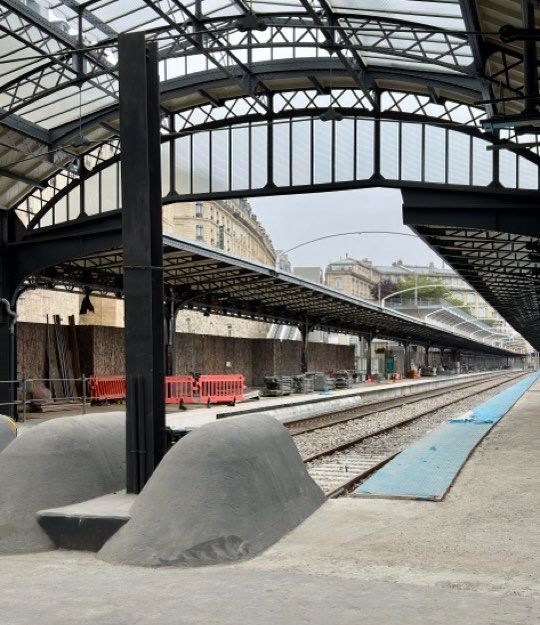
Work starts at the end of this month to replace the bridge that carries Transilien Line K and Paris – Laon Trains over RER Lines B and D outside Gare du Nord, tracks that will also be used by CDG Express. A 143m Warren truss has been chosen so as to reduce the number of supports required between the tracks. Commissioning is planned for 15th August 2025.
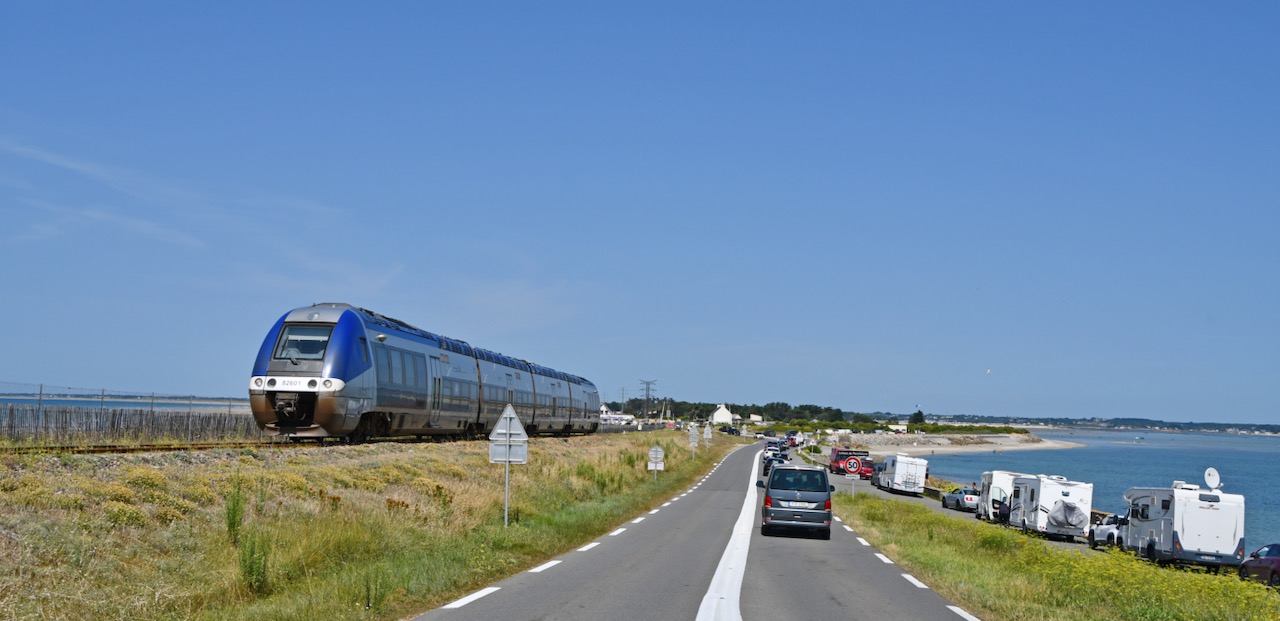
Summer only
The 28km branch from Auray to Quiberon in Bretagne, marketed as the Tire-Bouchon (cork screw), is served only during the summer months, running weekends from 15th June until 8th September and every day during July and August. Having lost year-round trains in the 1960s, the line subsequently saw just two A/R daily in summer. Then in 1985 heavy traffic on the narrow road serving the peninsula led Bretagne and SNCF to launch a frequent shuttle service to encourage holidaymakers to head for the beach without their cars. Today, trains run roughly hourly passing at Plouharnel-Carnac, with one Sundays-only A/R from Rennes. The service carried 150,000 passengers in 2023.
On 11th August B 82601/02 is seen leaving Isthme-de-Penthièvre with TER 854539 14.07 Auray – Quiberon. Photo: David Haydock.
By contrast, the 2km summer-only extension of Bordeaux – Le Verdon trains to Pointe-de-Grave, whence a ferry runs across the Gironde estuary to Royan, attracted only 2,435 passengers last year, though this was the best figure for a decade. Below left. In the last week of this year’s service, B 81500 No 81843/44 waits at Pointe-de-Grave on 28th August with TER 866130 12.13 to Bordeaux. Photo: Chris Bushell.
Both lines once had overnight through coaches to and from Paris. Below right. Thirty-four summers ago, on 26th July 1990, BB 9439 waits departure at Pointe-de-Grave with a couchette, seating car and fourgon forming Train 4668 20.23 to Paris Austerlitz. Photo: Phil Richards.
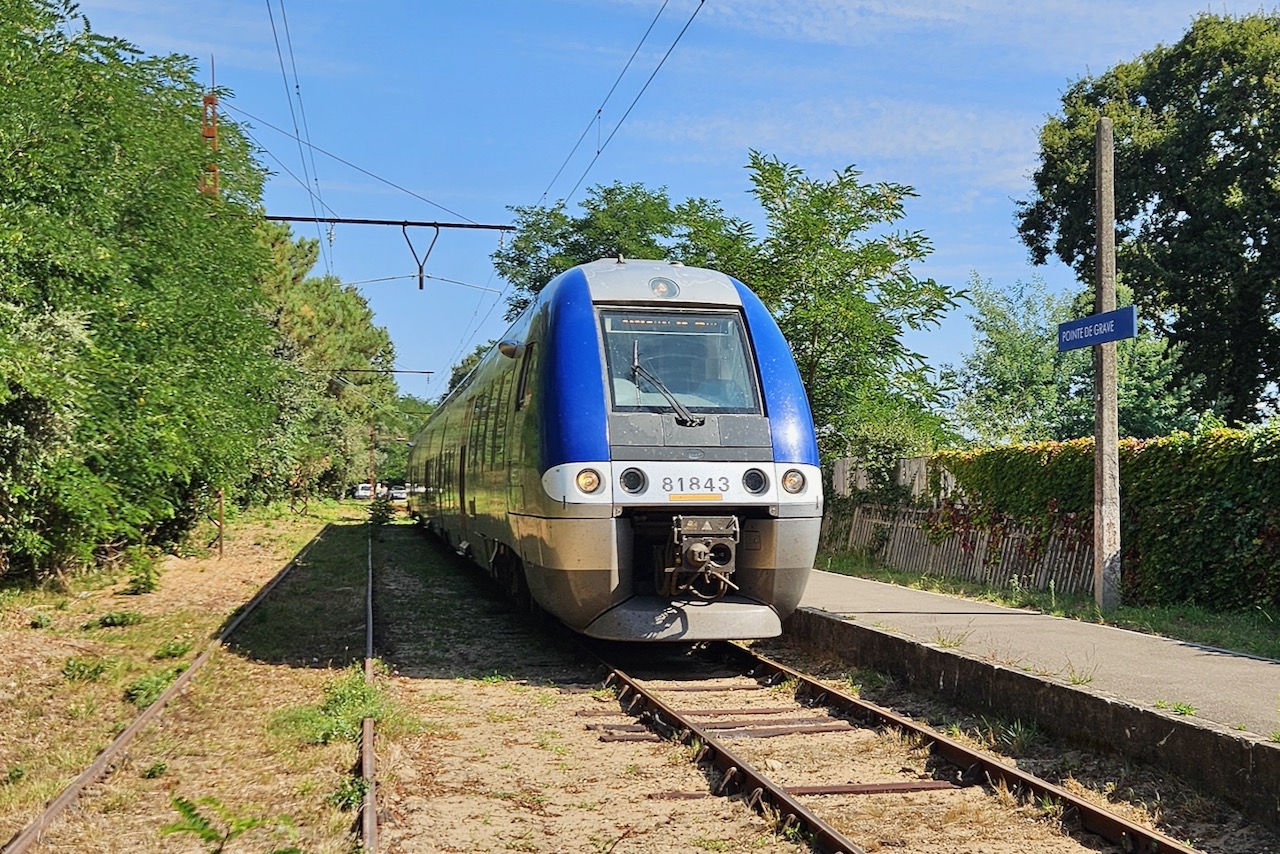
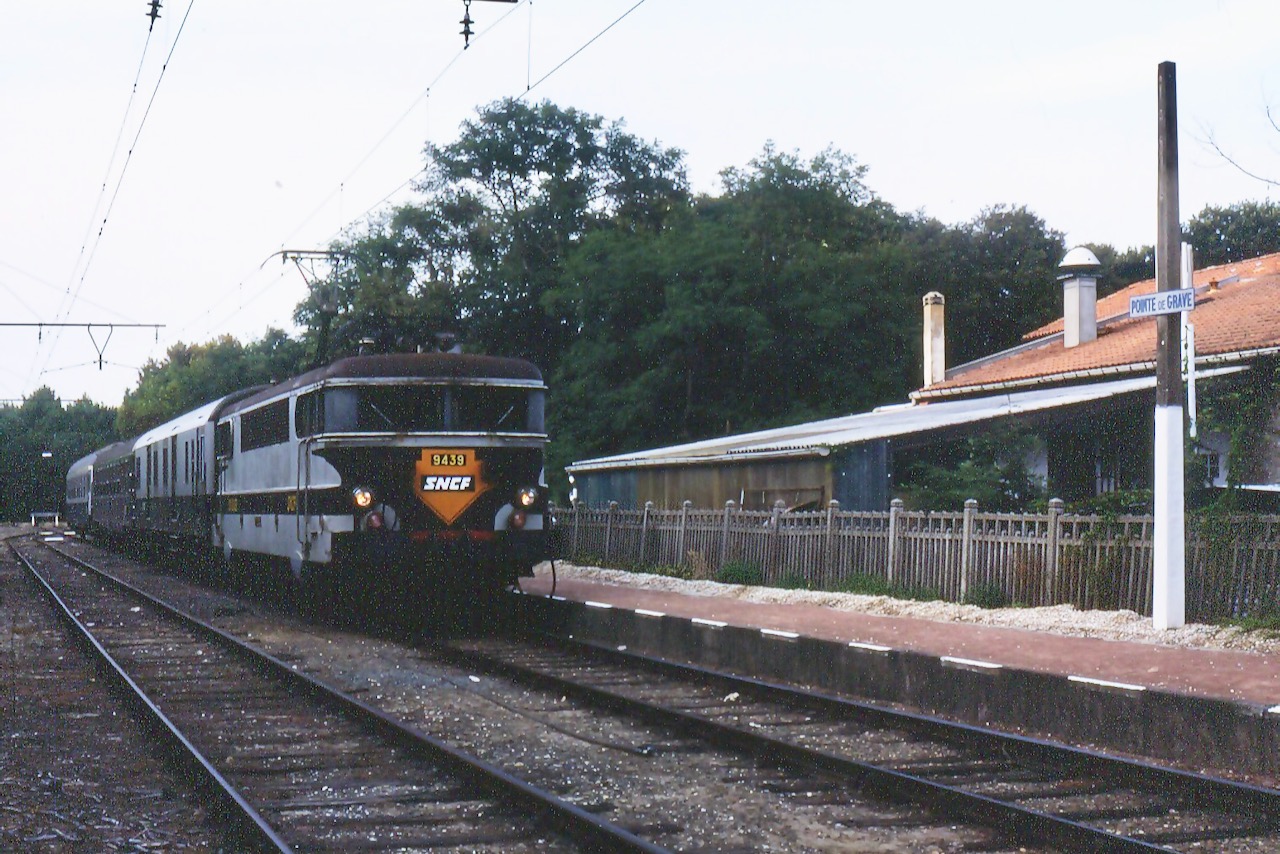
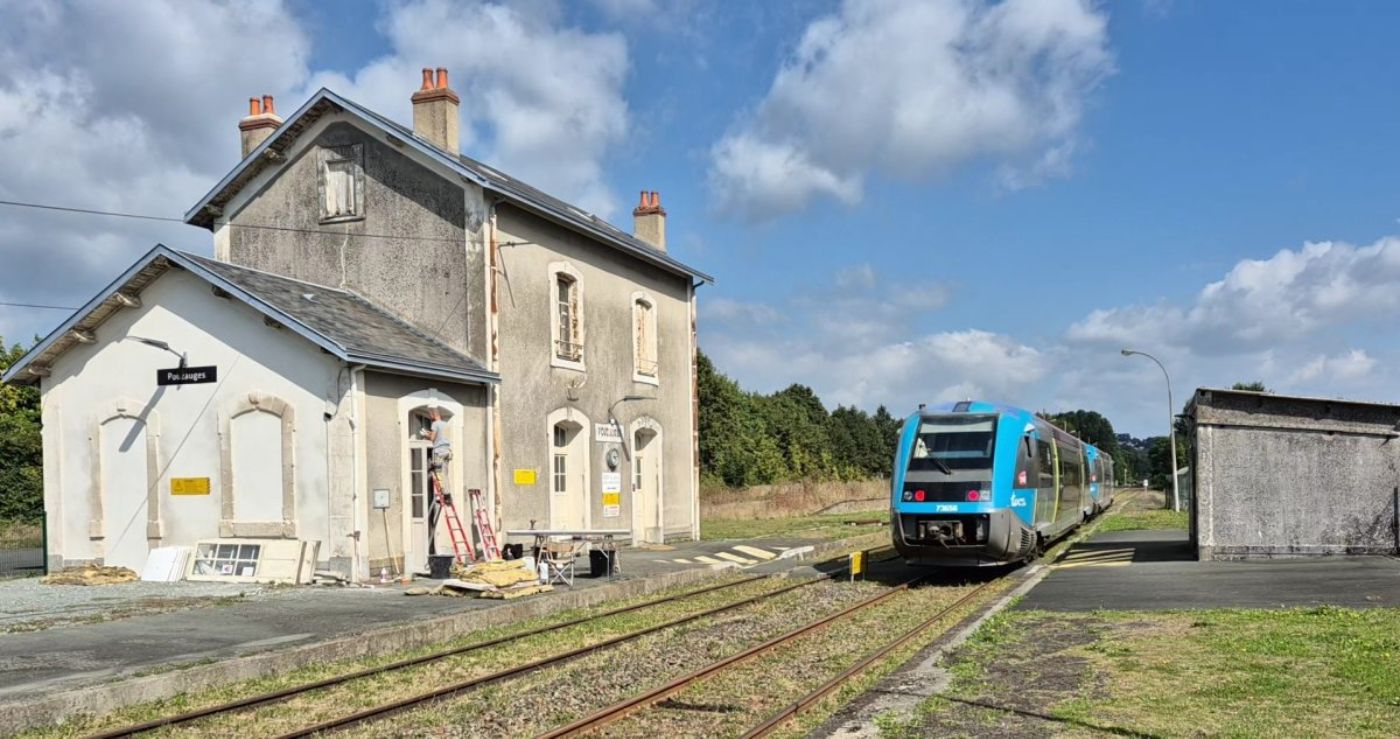
Pause at Pouzauges
The caption to August’s photo of the Saumur – Les Sables-d'Olonne Train des Plages was wrong to say that this is the only regular passenger train on the 52km section between Bressuire and Chantonnay. There is also a single year-round weekdays-only A/R La Roche-sur-Yon – Saumur – Tours train, unfortunately timed to make out-and-back journeys impossible.
On 18th September, a pair of saucisson X 73563/73656 on TER 863755 14.02 La Roche-sur-Yon to Tours calls at Pouzauges, which along with neighbouring Cerizay sees only this one train each way daily. The station here is well south of the town (population 5,500), overshadowed by a Fleury Michon food processing plant. Despite the poor service, part of the station building is undergoing renovation. Passenger numbers have increased over the past 10 years, amounting to 2,133 in 2023, but on this day no one alighted or boarded.
Photo: John Bamforth.
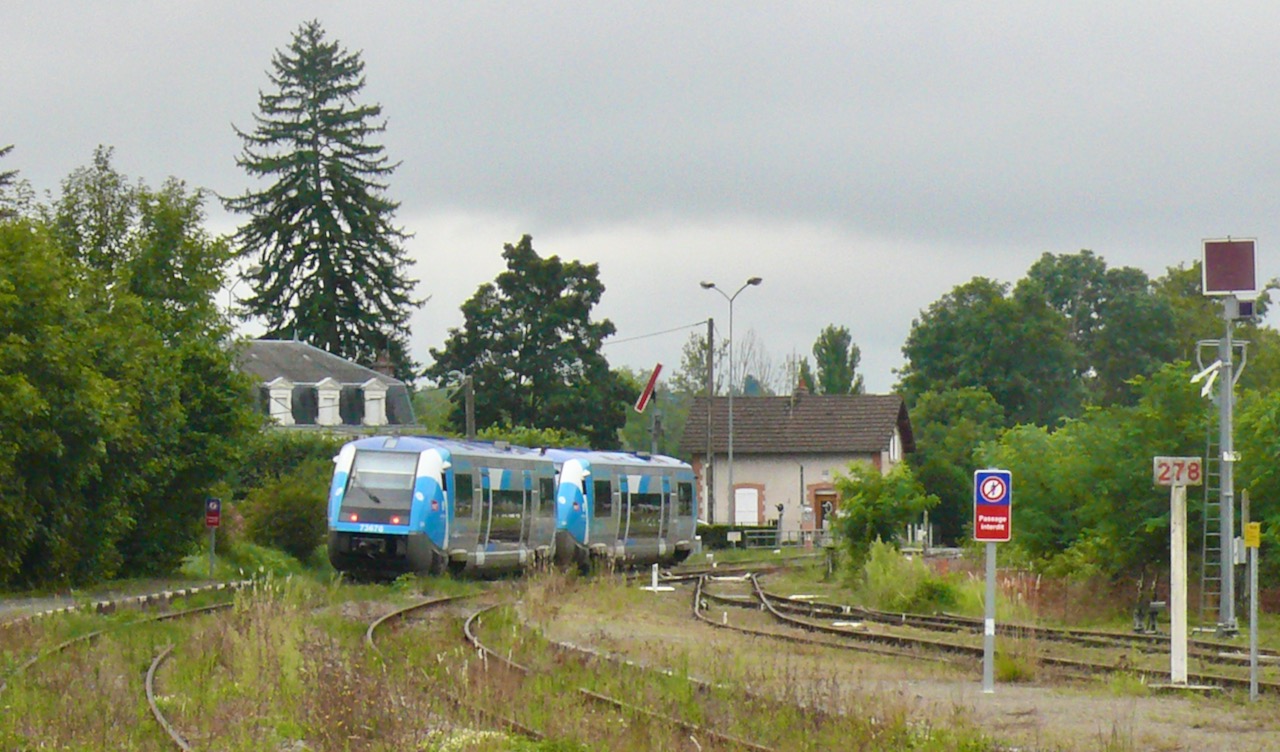
X 73684/73676 leaving Saint-Amand for Montluçon on 14th September. This section is still manually signalled despite the substantial recent investment in the infrastructure. Resignalling with new-generation automatic block is scheduled in a later phase of the upgrade.
Montluçon – Bourges reopened
Montluçon’s rail link with Paris was re-established on 2nd September after 14 months’ upgrading work at a cost of €85 million. The 109km line to Bourges has been partially rebuilt (see July News) for a 9min saving in journey time, but as reported the outcome is not considered satisfactory in Montluçon (population 30,000). There are just six Up and five Down Bourges services on weekdays, a timetable which ‘is being introduced progressively’ through to 28th October according to SNCF because of continuing disruption caused by POLT upgrading at Vierzon. Trains run direct to Vierzon at weekends when the works are suspended, and some connections are still provided by non-stop bus. There are also a handful of short workings to and from Saint-Amand-Montrond-Orval.
Paris journey times remain well over 3h, considerably longer than the 2h 50 of through trains in 1980. With strong local demand for resumption of direct service, Centre-Val de Loire transport vice-president Philippe Fournié is negotiating with SNCF and is hopeful that a peak-hour A/R through train could start in 2025. Its route has yet to be determined but the aim would be to run direct to Vierzon via the south-to-west curve at Pont-Vert to avoid reversal at Bourges, thus saving 20min. It is understood that a Paris journey time of under 3h is no longer considered realistic.
Both photos: Pete Brendon.

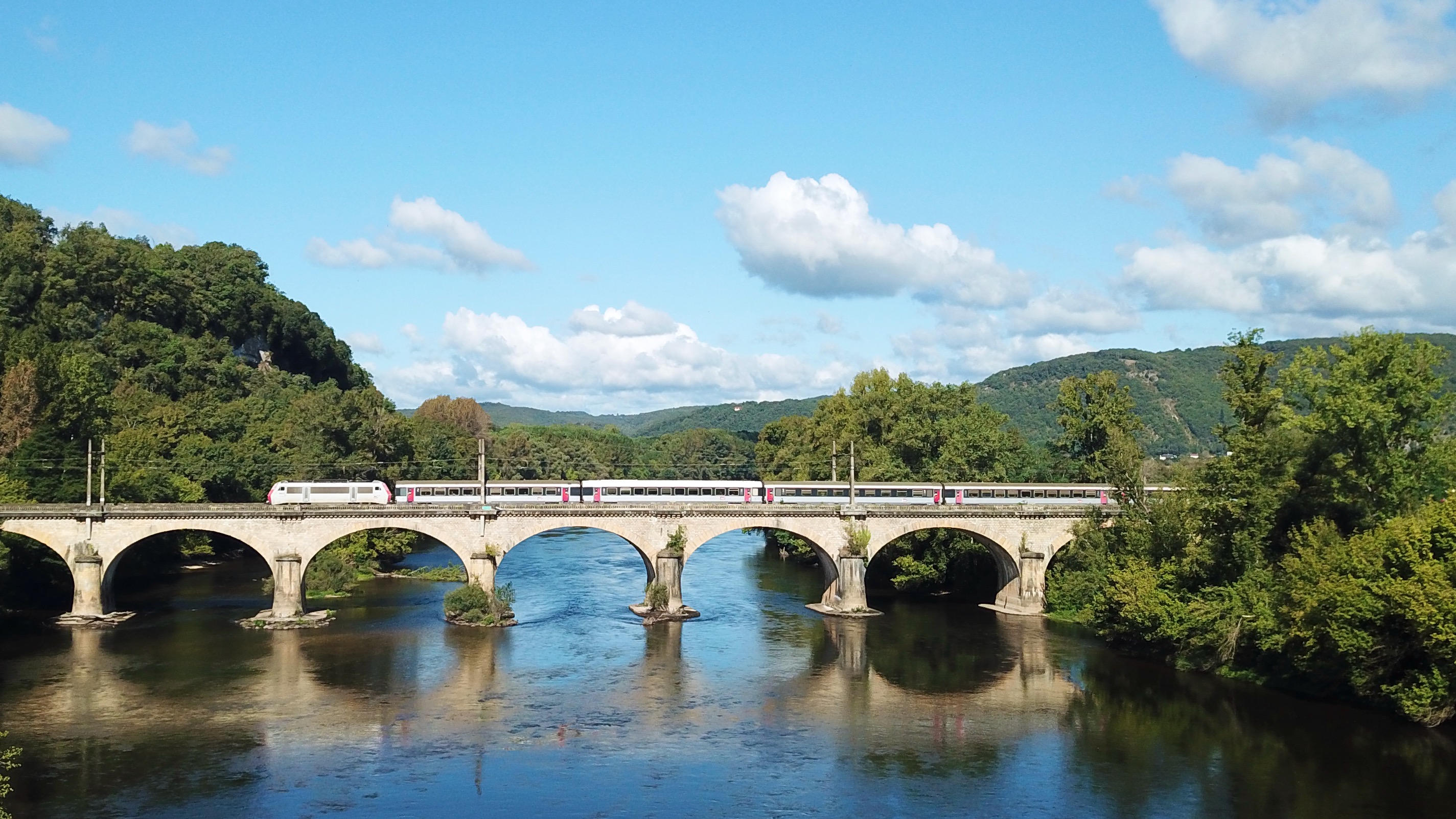
A Class BB 26000 crosses the Dordogne south of Souillac on the 13th September with the Intercités 3605 06.28 Paris Austerlitz – Toulouse. The roof of the second coach has been painted white to reduce the impact of solar gain. This was promoted as a major initiative after the excessive heat of 2023 but only a small number of V200 Corail coaches have been treated, and none of the V160 stock used on the 3619 08.28 Paris Austerlitz – Toulouse and 3650 10.27 Toulouse – Paris services.
Summer: busy but…
Busy, but not as busy as expected. Instead of the record traffic that SNCF had forecast, “We did not see passenger numbers like previous summers” said Christophe Fanichet, head of SNCF Voyageurs. Results for July and August show 24 million passenger-journeys on TGV and Intercités trains, 1% up on last year’s figure. July was “rather sluggish” according to Fanichet. Poor weather, the 14th July holiday falling on a Sunday, and the unstable political climate impacted people’s travel plans even before the acts of sabotage which crippled much of the LGV network on 26th July, normally one of the busiest days of the year. Some 800,000 passengers were booked on TGVs that day, of whom 700,000 eventually reached their destinations. Rapid mobilisation of repair teams brought services back into operation sooner than had been expected, at a cost of “several millions of euros” Fanichet said.
August made up for July’s disappointment; trains were particularly busy during the Olympic Games when 450,000 additional seats were provided. Journeys were up 4% on 2023’s figure. Certain destinations benefited from the Olympic effect, such as Lille (where basketball and handball were played) with a 67% increase in passengers. Average train occupancy was the same as last year, 84%.
International trains carried 6 million passengers, also the same as 2023. Coastal destinations were as popular as ever but routes to the Alps turned in the best performance, with a 15% increase in journeys. Thanks to the boost from 2.4 million Pass Rail journeys, TER patronage was up 10%.
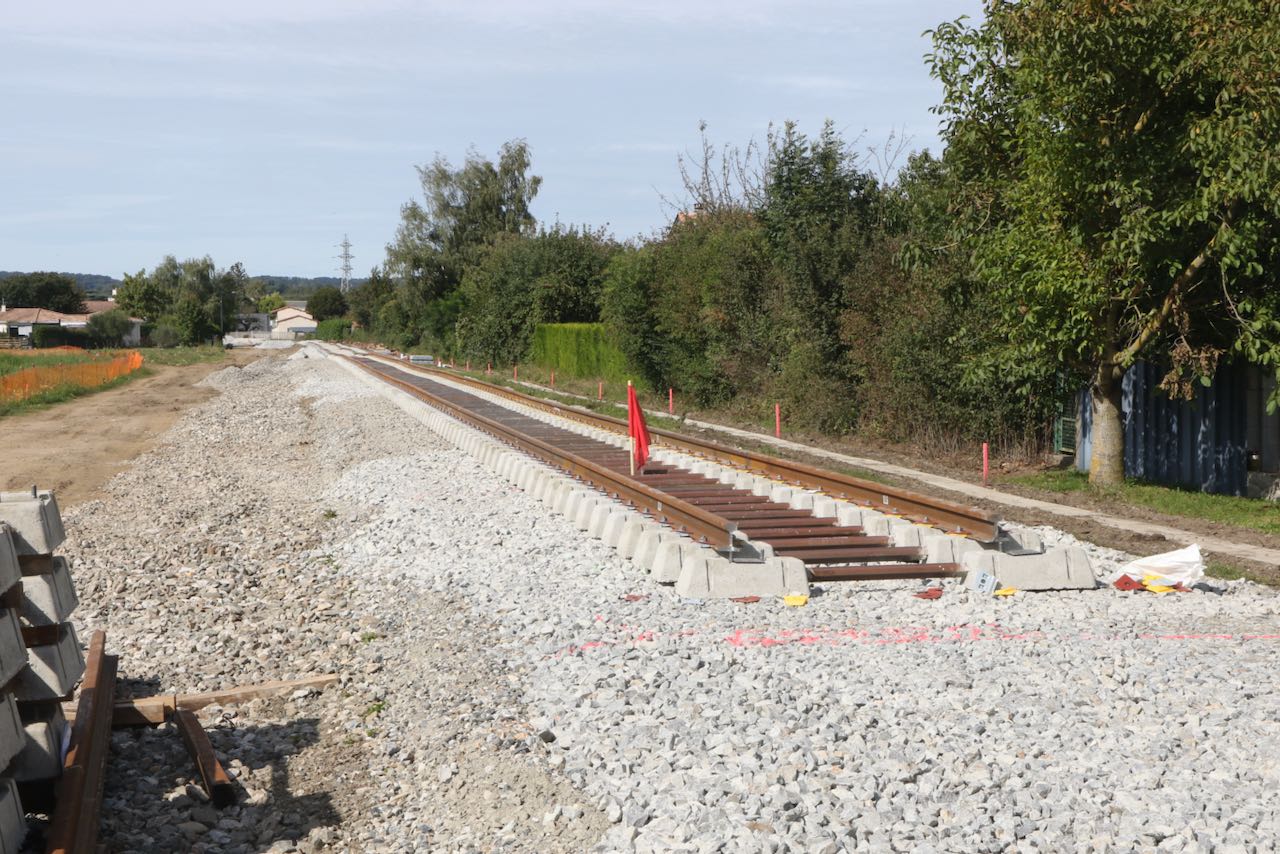
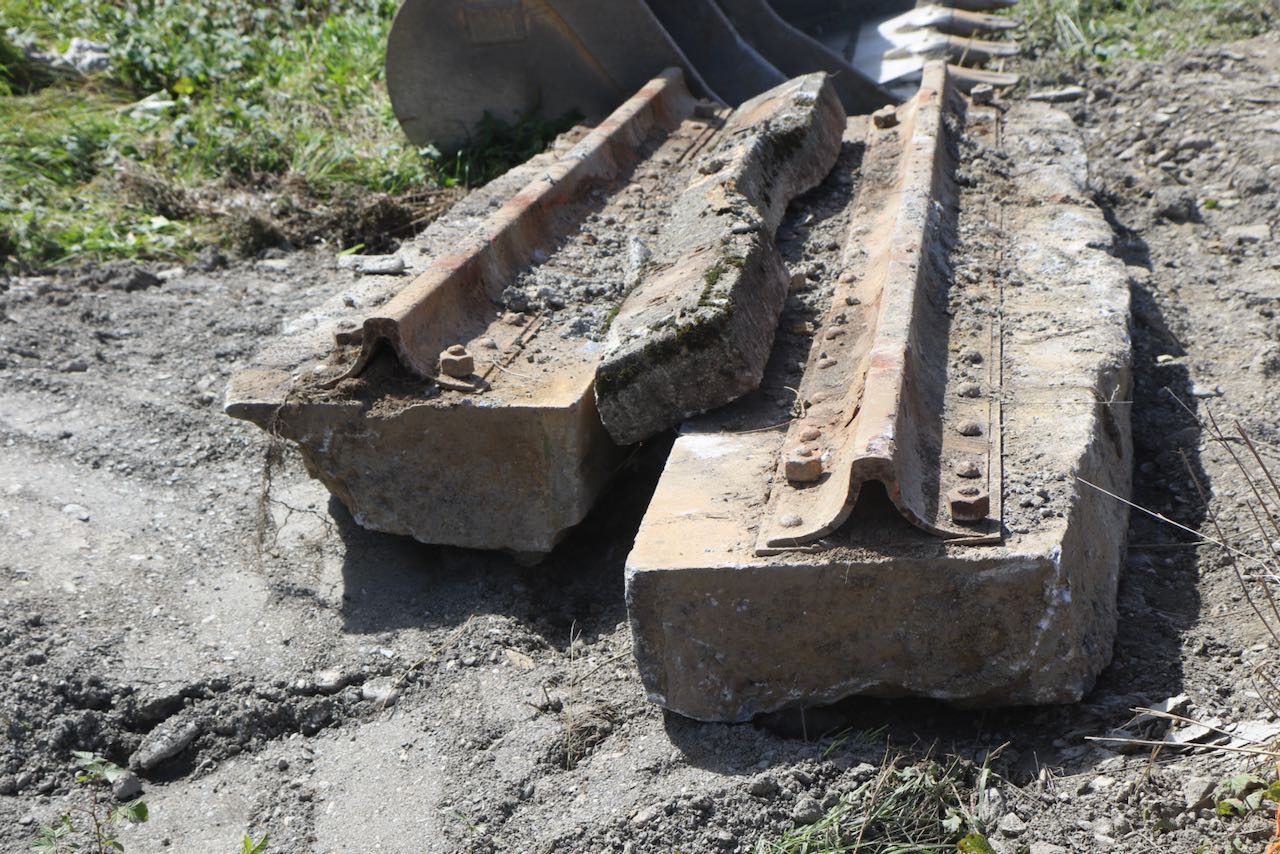
Montréjeau – Luchon track relaying
Reopening of the line from Montréjeau to Luchon came a step closer in September with the start of tracklaying. Photo above left shows the position a few hundred metres beyond Montréjeau station. Work on the line has included rebuilding some of the weaker bridges. At Cier-de-Luchon, among the remains of a bridge now rebuilt, these sections of Barlow rail came to light. Rolled around 1850 in Decazeville, they are thus over 170 years old! Having been recovered after use elsewhere on the Midi, they had been reused to reinforce the bridge.
Both photos: Georges Turpin.
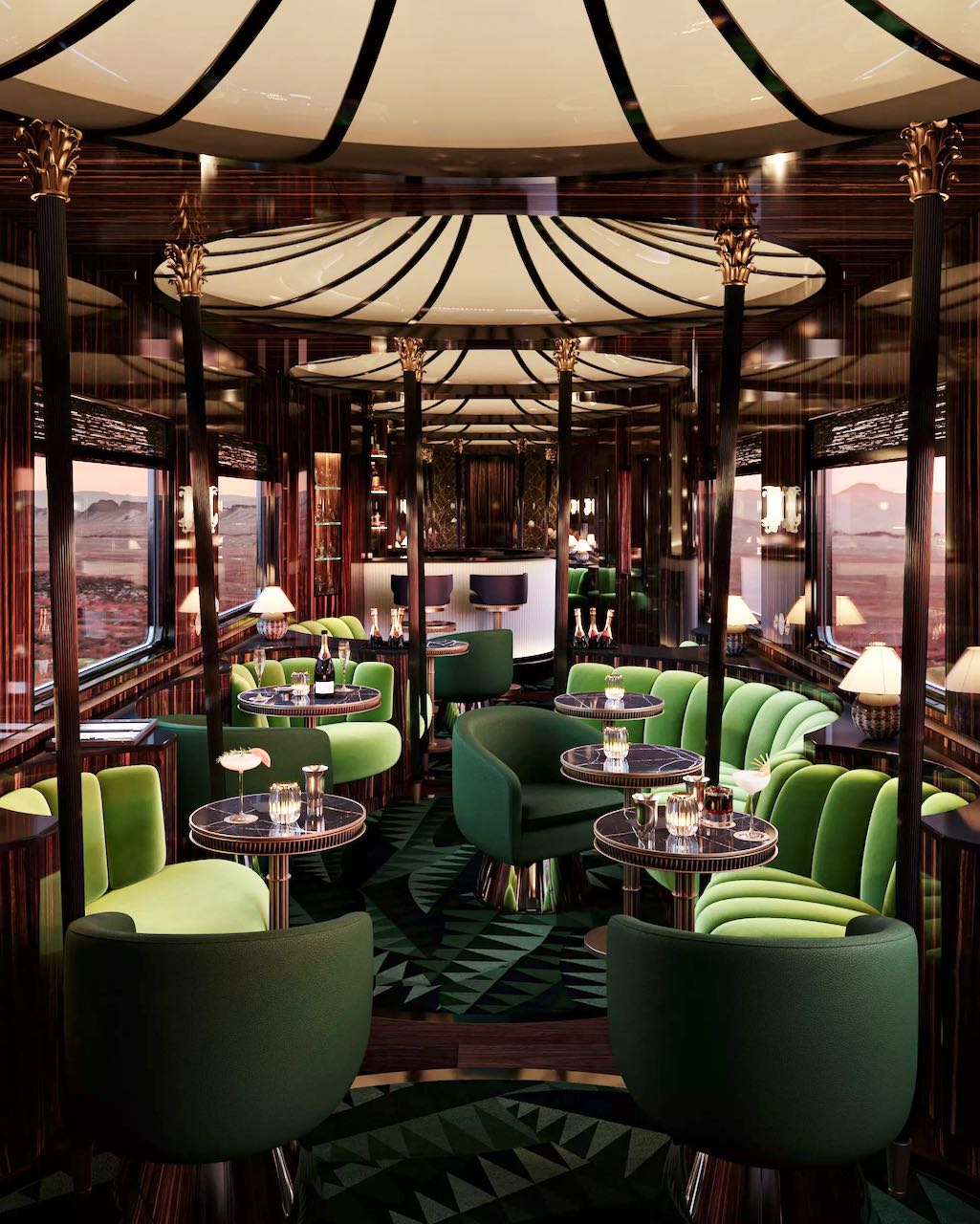
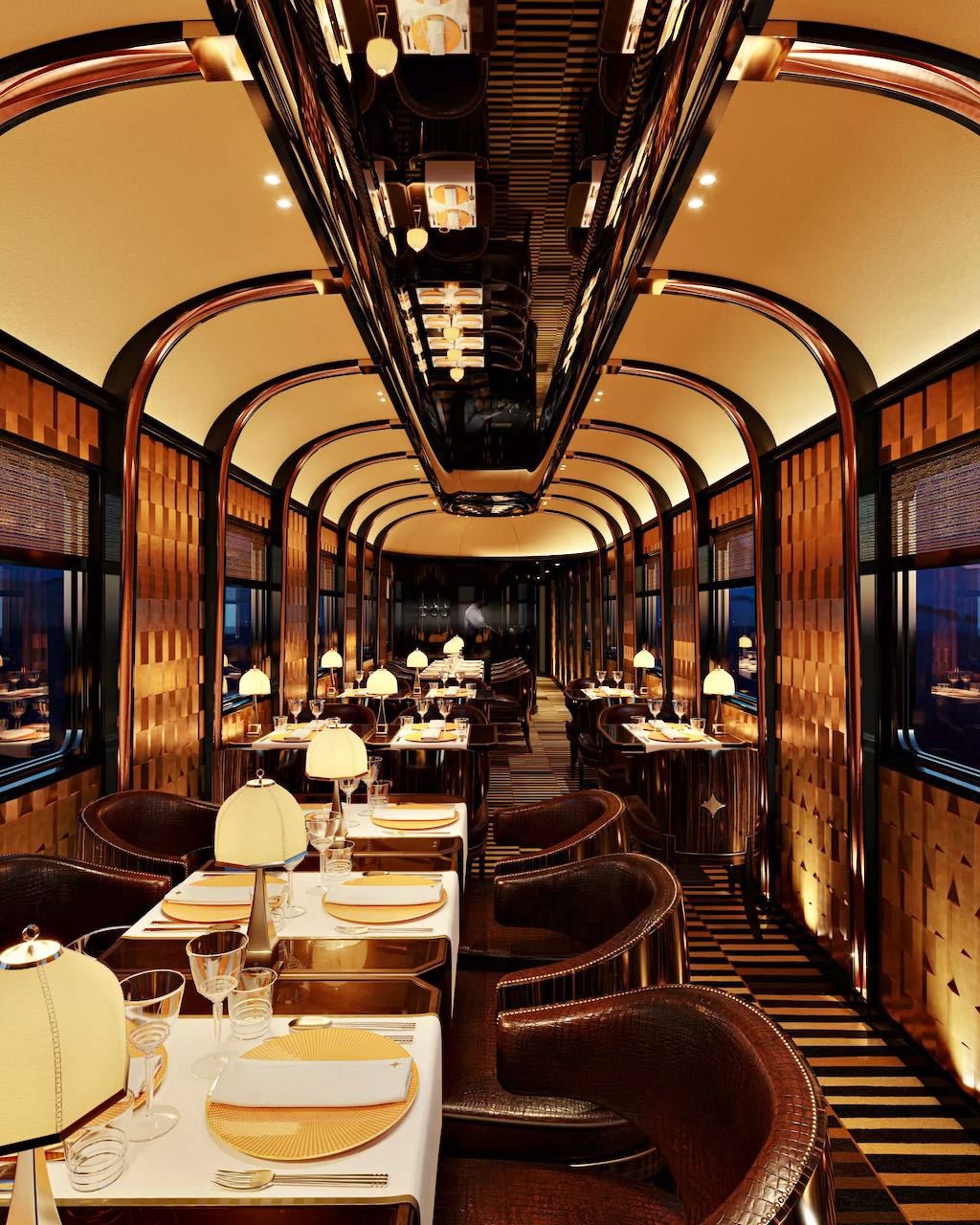
The café-bar (above left) is inspired by the bar of the 1883 Orient Express, recreating the spirit of late-19th Century Paris. Amongst the many fine details, tables have push-buttons for ordering champagne. There is also a piano for live performances. In the dining car (above right), the ‘rail’ motif created by Suzanne Lalique, daughter of the famous craftsman René, has been worked into the wall panelling. A small private dining coupé is separated from the main area by glass screens.
Orient Express on show
Hotel group Accor, which bought the Orient Express brand from SNCF in 2022, has released photos of CIWL cars undergoing restoration for relaunch of the train. Under an agreement signed in June, LVMH (owner of the Belmond luxury train operator) has joined forces with Accor through a strategic investment in the brand and the company that plans to relaunch the Orient Express as a luxury train between Paris and Istanbul in late-2026.
Accor has acquired 17 CIWL cars dating from the 1920s and 30s that had run in the Nostalgie-Istanbul-Orient-Express, revived in the late-1970s by Swiss businessman Albert Glatt. After NIOE ceased operation, the cars ran in various tourist trains before going into store at locations in Poland (13 cars), the Czech Republic and elsewhere. Accor bought those stored in Poland in 2018 and the Czech cars in 2021, bringing them back to France for restoration. Surprisingly well preserved, the interiors have their original Morrison & Nelson marquetry, as well as the Lalique panels so characteristic of the Art Deco style engraved with ‘blackbirds and grapes’ motifs.
The vehicles comprise 12 sleeping cars, a restaurant car, three saloons and a fourgon. They are being restored under the guidance of interior designer Maxime d’Angeac, who has reinterpreted the classic CIWL decor for the 21st century traveller. His brief was to ‘find a perfect balance between past, present, and future’. Work is being carried by ACCM at Clermont-Ferrand with input from a range of French crafts specialists, including glassmakers, master-sculptors, upholsterers, marquetry and cabinetmakers, carpets and lighting.
Amongst the three classes of luxury accommodation is a 55m3 presidential suite, and one of the saloons will be equipped to host live performances and events. Whereas the original sleeping cars had five pairs of cabins each with shared washing facilities, the redesigned cars have just three rooms, all with spacious private bathrooms. The restaurant car will serve modern interpretations of some of the classic CIWL menus. Photos: ©Accor Group/Maxime d’Angeac and Martin Darzacq.
Georges Nagelmackers, creator of the first Orient Express, developed the idea of the ‘great transformation’, where in daytime it was barely apparent that the sofas would be converted to sleeping accommodation whilst passengers dined. This aspect has been respected in the redesign of cabins for the needs of today’s travellers. The two views below show the same cabin in day and night modes. Like the originals, all furniture has rounded edges to avoid bumps. The carpets evoke another Suzanne Lalique design, and genuine Lalique glass is displayed in niches.


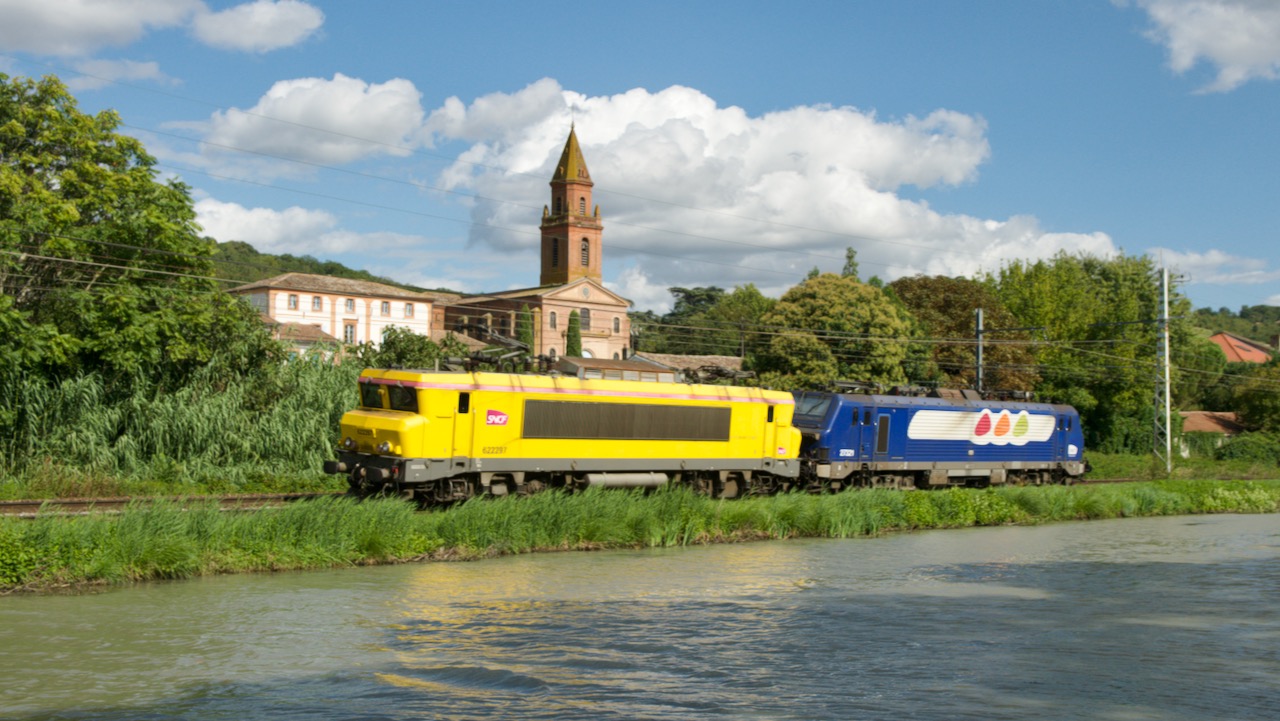
BB 27300s to Infra
Following the sale of 12 Class BB 27300 to Beacon Rail for use by Regiorail, a further 12 (27302/03/06/07/09/11/13/15/17/19/21/22) locomotives have now been transferred to SNCF's Infra sector. On 12th September BB 22297/27321 are seen running beside the Canal Latéral à la Garonne at Pompignan with an unladen 66628 07.57 Portes - Bordeaux Hourcade.
The Convention of European Railway Societies - Saturday 19th October 2024
Thringstone Club, 126 Loughborough Road, Thringstone, Coalville, Leicestershire LE67 8LR
10am to 4.30pm. Admission – Adults £5, accompanied children under 16 free.
We are participating in this event along with the Austrian, German, Italian, Scandinavian and Swiss Railway Societies. There will be stands and layouts from each Society plus trade stands from Contikits, Scograil and Mount Tabour.
More details of exhibits can be found on theUK Model Shops Website
We are participating in this event along with the Austrian, German, Italian, Scandinavian and Swiss Railway Societies. There will be stands and layouts from each Society plus trade stands from Contikits, Scograil and Mount Tabour.
More details of exhibits can be found on theUK Model Shops Website
News in Brief
GCA Traction. This new train operator received its licence on 5th July. It is a subsidiary of Groupe Charles André, a transport and logistics company based in Montélimar covering the whole of France. In 2013 GCA took over Novatrans, an ailing subsidiary of SNCF which operated intermodal services. For a decade Novatrans subcontracted traction to Fret SNCF but when the EC forced the national operator to shed a series of services last year, including four Novatrans routes, GCA decided that the company would take traction in house.
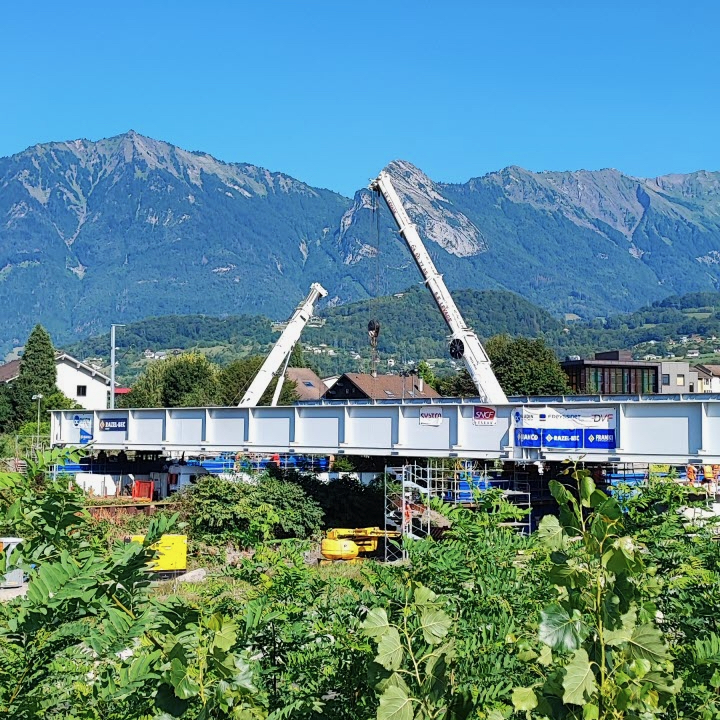
Albertville. The new deck of the pont d’Arly on the line to Bourg-Saint-Maurice was rolled into place during the week of 21st August. SNCF Réseau has been working for over a year to renew the structure dating from 1891. Early morning and evening trains from Bourg-Saint-Maurice were replaced by buses until 27th August. The old deck will be cut up and removed before completion of the €8.5 million project in November. Photo: Le Dauphiné Libéré/AP.
Farandou honoured. Outgoing PDG Jean-Pierre Farandou has been awarded Ukraine’s Order of Merit in recognition of the assistance afforded by SNCF to refugees, including free transport and use of railway housing, as well as provision of materials and equipment to help keep Ukrainian Railways functioning.
New minister. François Durovray was appointed transport minister in the new government announced on 21st September.
Wagon-Bar. A new history of French train catering was published at the end of June. Wagon-Bar. Une petite histoire du repas ferroviaire, by Arthur Mettetal, Géry Nolan and Jean-Pierre Williot, published by Textuel at €29. .https://www.editionstextuel.com/livre/wagon-bar
Autun. Ticket sales transfer this month to the town’s Espace Mobilité adjacent to the station where Transdev staff now provide the service following closure of the SNCF ticket office.
TGV M. A report in Le Parisien suggested that entry into service might be further delayed following the incidence of vibration in the driving cab during tests at over 350km/h. Alstom said that ‘technical adjustments’ would not delay delivery of the first sets in mid-2025.
Paris – Berlin. SNCF and DB will introduce a day train between the two capitals with the December timetable change, journey time around 8h 05. An ICE set will be used in both directions, departing Gare de l’Est at 09.55 and Berlin Hbf at 11.54 and stopping at Strasbourg, Karlsruhe and Frankfurt Süd.
Baggage rules. The previously-announced limits on baggage that can be carried on TGV and Intercités trains came into force on 15th September, with fines of €50 for transgressors. Labelling of luggage is also being enforced. Social media has reported contrôleurs taking a hard line with passengers unable to show digital tickets because there was no phone signal (fine €135).
Strasbourg. Investment of €70 million aimed at doubling the amount of rail traffic (900,000 tonnes in 2023, mainly containers) through the Port of Strasbourg was announced on 4th September. A new multi-modal terminal will be built to serve the port’s southern hub, complementing those at the northern portal and nearby Lauterbourg. The first phase should be operational by early-2027.
Pont des Anglais. Europe’s oldest metal bridge, Pont Victor Emmanuel at Cruet, just east of Montmelian on the line from Chambéry to Modane, also known as the Pont des Anglais, is threatened with demolition. Unused by trains since 1876 when the railway was diverted to the opposite bank of the Isère, the bridge carried cars and pedestrians until designation as a national monument in 1994.
LNPN. Officials of Île-de-France voted against approving the proposed Paris – Normandie LGV on 11th September, citing repeated dismissal by the State of the région’s objections. “We are asking the State to abandon this project, which makes no sense in either ecological or economic terms,” said Jean-Philippe Dugoin-Clément, the région’s vice-president of planning.

Vesoul. The station building was badly damaged by fire on 14th September, causing the ceilings to collapse into the passenger hall. Paris – Belfort – Mulhouse trains were cancelled or diverted until the 29th and a limited service ran eastwards to Belfort. Photo: L’Est Republicain/Patrick Bar.
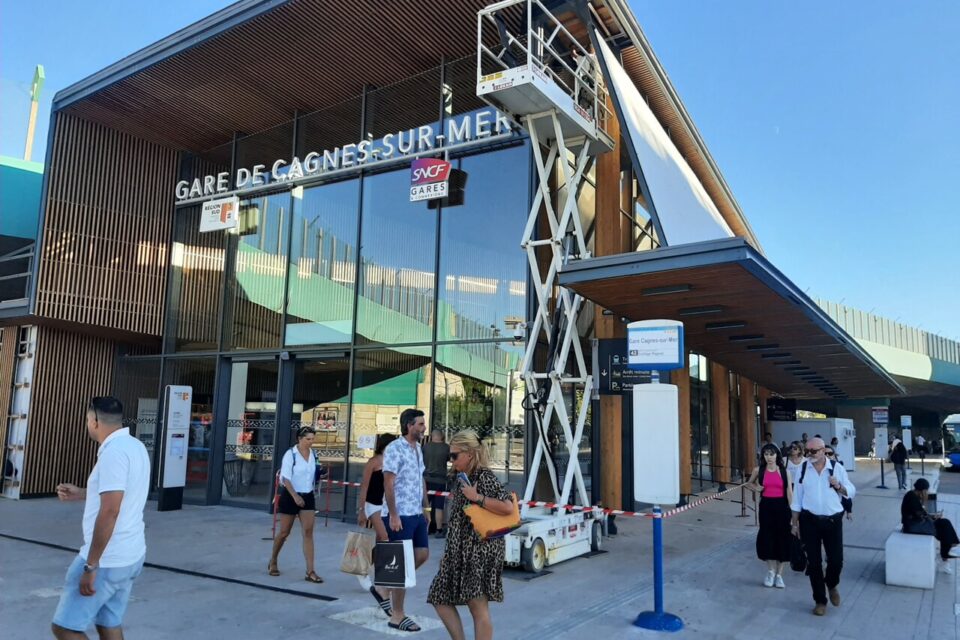
Cagnes-sur-Mer. The new station building and multimodel interchange opened at the end of September after several years’ work costing €27 million. Photo: actuNice/CBL.
Arve valley. A full timetable will be operated from December on the line between La Roche-sur-Foron and Saint-Gervais-les-Bains Le Fayet, where the hourly service has been curtailed since October 2022 due to shortage of staff and rolling stock. Four EMUs will be available instead of the two currently running the service.
Grants for intermodal. The European Commission has approved state aid of €6.3 million towards development of the CargoBeamer intermodal hub at the port of Calais, and €3 million for a similar scheme at Sète for Terminal Société Investissement, an SNCF group subsidiary.
Angoulême. Work started last month on renovation of the marquise, including anti-corrosion measures and protecting the 3,000m2 of glass against the sun. The 16-month project is costed at €17.4 million.
Hagenau. €1 million has been provided by the state and Grand Est région for preparatory studies of electrification between Vondenheim and Hagenau (24km).
Epernay. Foundations were laid on 28/29th August for a 170m footbridge across the station tracks to link the town with the new Berges de Marne development, due to open in a year’s time. Along with renovation of the station building and accessibility works to be completed in 2026, a total of €33 million is being spent.
Nice – Breil. Région Sud PACA has tried to counter disquiet about the Nice – Breil-sur-Roya – (Tende) line’s future by reaffirming its investment of €56 million in the current upgrade. A week before the line was partially closed for 16 months, PACA said the modernisation would ‘save the Roya railway’. Work includes structural repairs to Braus and Mont Grazian tunnels, renovation and stabilisation of the infrastructure, drainage and track repairs. Signalling alterations would make it possible to run a half-hourly service between Nice and Drap and hourly to Breil from 2027.
Other works getting under way in PACA include overnight closures between Nice and Vintimille until next June for OHL renovation, tunnel maintenance, accessibility work at Villefranche-sur-Mer, and construction of a multimodal interchange at Beaulieu-sur-Mer. SNCF Réseau temporarily conceded a later start of the closure, from 21.00 until 22.45, after protests from PACA région and Monaco, which described the loss of late trains as ‘unacceptable’. In addition, Miramas to Avignon via Cavaillon is closed off-peak until 14th December for track upgrading, as is Saint-Antoine to Aix-en-Provence for stabilisation of rock cuttings.
Channel Tunnel. Getlink has completed a three-year programme to equip its terminals to cope with the EU Entry/Exit System being introduced next month. The facilities can handle 2,000 passengers and up to 700 vehicles per hour.
Brive – Rodez. Trains were cancelled several times during August when staff were unavailable to supervise crossing movements at Saint-Christophe and Viviez-Decazeville. Rodez station was closed all morning on the 18th. SNCF regretted the closure, blaming staff sickness at a time when numbers were already reduced due to holidays.
Access fees. Regulatory authority ART has approved SNCF Réseau’s proposed access charges for TER trains for 2024, 2025 and 2026, an average rise of 8% per year. The increase is opposed by eight régions as being ‘absolutely beyond our means’; fares are to remain unchanged for the present.
CAF. In the absence of further orders, CAF will close the Régiolis production line at Reichshoffen once the order for Grand Est cross-border trains (see item above) is completed at the end of the year.
RENFE. Poor reliability of its S 106 trains is reportedly delaying extension of RENFE’s French operations from Lyon to Paris. A total of 479 ‘technical incidents’ occurred during the first months of operation in Spain, with punctuality falling below 50% at the beginning of August. In addition to RENFE’s claim of €166 million against Talgo for late delivery of the trains, recompense may be sought for the disruption caused by breakdowns.

Siemens and leasing company Alpha Trains have announced an umbrella agreement for 70 Multi Service (MS) and Dual Mode Vectrons. The agreement includes a firm order for 35 locomotives, including MS versions for France, that will be able to operate cross-border traffic to Belgium, Germany, Switzerland and Italy.
It is unclear who the likely operator will be or what traffic flows will be handled. The locomotives are for delivery from the end of 2026. Siemens has been seeking approval for operation of MS Vectrons in France. As reported in July 2023 News, No 193 920 spent three weeks at Plouaret-Trégor in Bretagne during June 2023 undergoing track circuit trials. Photo: Siemens.
Redon. The bridge over the Vilaine river east of Redon station, which carries trains to and from Rennes and Nantes, is to be replaced at a cost of €26 million in a 30-month project starting in 2026. There will be no interruption to traffic except for a week in 2027 while the 43m central span is commissioned.
Brussels – Paris. SNCB’s EuroCity service via the classic route, offered during the Olympic Games period (see July News), will become permanent from the start of the winter timetable on 16th December. Trains will call at Mons in Belgium and then run non-stop to Paris.
Night trains. Austrian Federal Railways has no plans to seek certification for its new Nightjet trains in France ‘because of the cost associated with the process’ according to a report in Railway Gazette. Problems with certification for running in other countries have caused ÖBB to pause expansion of its night train network.
Château-Gontier. The 30km freight line from Sablé-sur-Sarthe, renovated at a cost of €33.7 million (see March News), was officially inaugurated on 13th September. The weekly train of steel profiles and tubes for Maisonneuve will soon be supplemented by containerised slag coming from an industrial incinerator at Fos-sur-Mer for processing by Séché Environnement at an old chemical site at Gennes-Longuefuye.
Bordeaux – Pau. SNCF Réseau is to invest €200 million in the Bordeaux – Dax – Pau line to improve reliability. Timekeeping has suffered from infrastructure failings exacerbated by 2023’s severe storms, with only 76% of trains arriving within 5min of scheduled time last year. Following representations from Nouvelle-Aquitaine région, a five-year action plan was announced on 17th September designed to future-proof the route. Also included is resignalling of the 51km single-track line between Bayonne and Puyoô, where obsolete manual block causes significant delays.
Opposite Train 489292 Bayonne – Artix is signalled through the loop at Urt on 13th May with BB 7200 No 7357 hauling three VTG tankers.
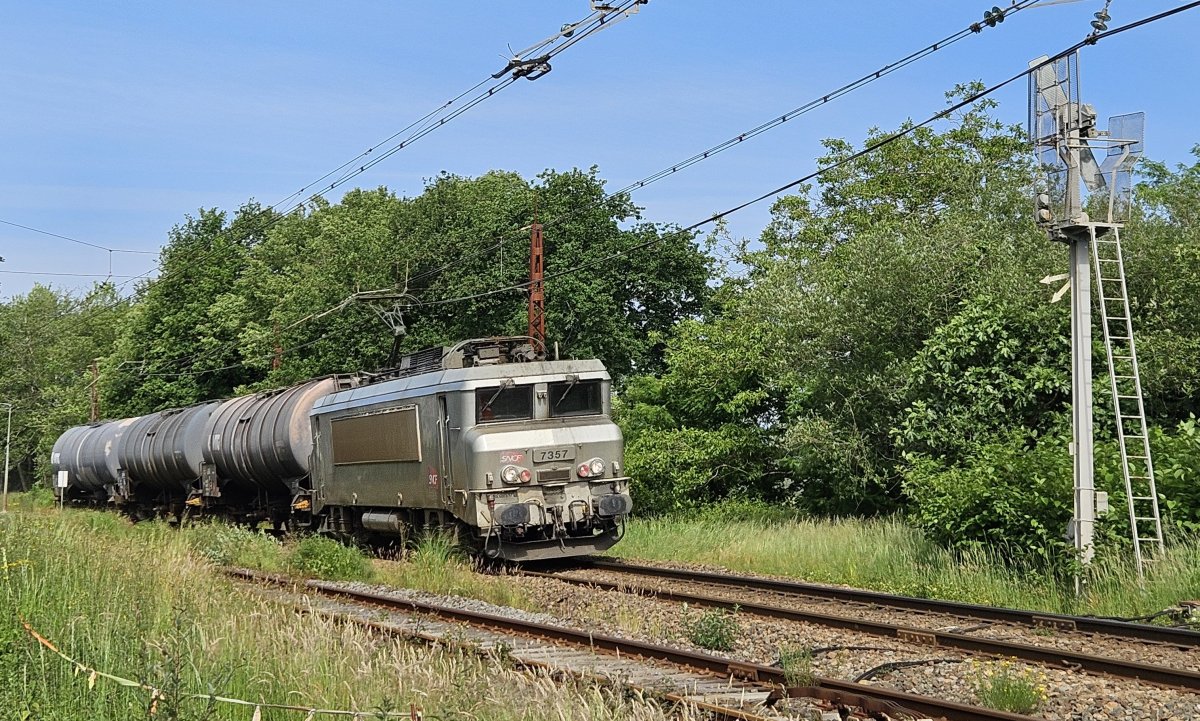
Ligne des Horlogers
A press visit on 3rd September found the Besançon – Morteau – Le Locle – (La Chaux-de-Fonds) line upgrade on schedule for resumption of passenger service on 1st November. In the second phase of a programme started in 2019, the route has undergone track renewal over some 22km; four bridges and other structures have been renovated, level crossings automated, drainage improved and vegetation cleared. Besançon-Mouillère and Saône stations have had their platforms raised to provide level access to trains, with information systems and signage replaced.
Several tunnels have been renovated to modern standards, with sprayed-concrete coating to stabilise weak stonework, new grouting, improved drainage and installation of lighting for safety reasons. Major work was concentrated on the 873m Morre tunnel (see above), where 84m of the lining received a 10cm coating of concrete over lattice reinforcement.
The current work has cost €56.2 million, financed by the State, Bourgogne-Franche-Comté region and SNCF Réseau. Completion at the end of this month will leave the line generally fit for the next 20 years, though SNCF Réseau plans a third phase of as yet unscheduled works.
Photo: MaCommune.info/ElodieR.
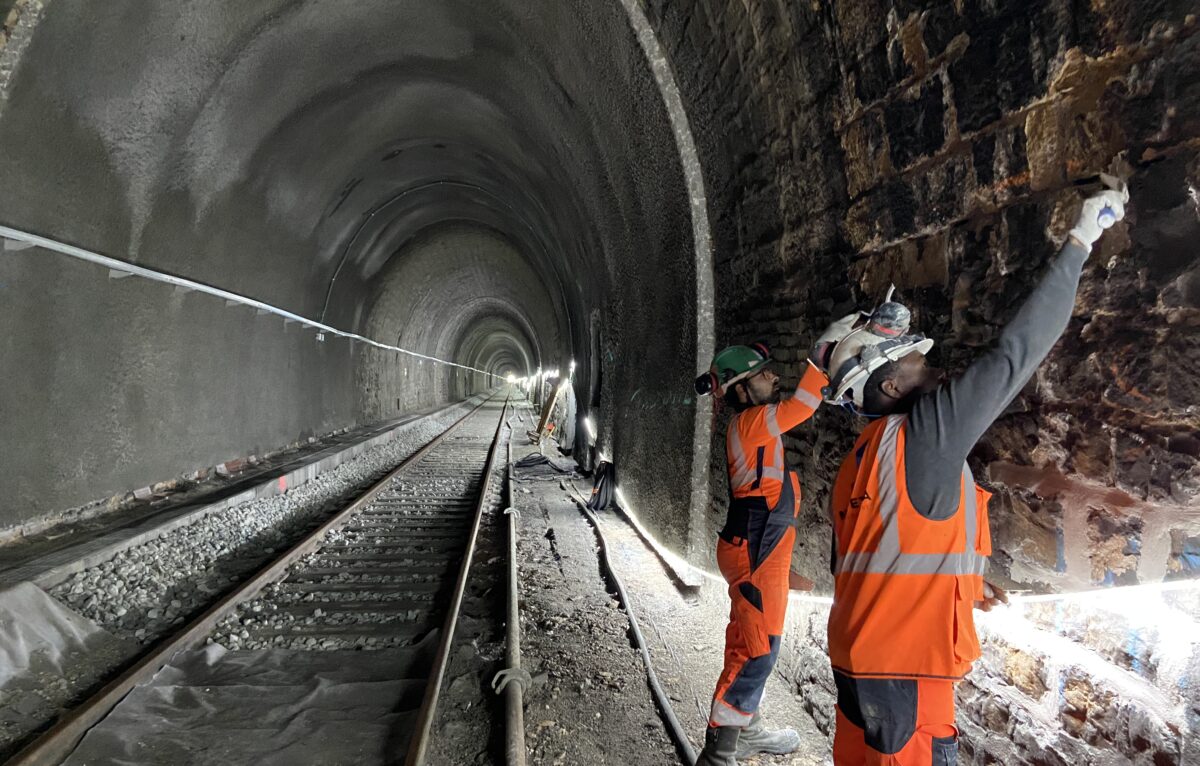
Corsican revival?
A new halt opens this month at Casatorra between Bastia and Casamozza, located north of the existing platform which is awkwardly situated and can only be accessed by crossing the track. Now there will be level access for passengers and parking for 30 cars. The €500,000 project is part of a wider upgrade of six stops on Bastia’s suburban service.
Roads south of Bastia are heavily congested and long-standing plans to reopen part of Corsica’s East Coast line are again being considered as a means of easing traffic congestion. The 130km line to Porto Vecchio was destroyed during World War 2 apart from a short section from Casamozza to Folelli (13km) which ran until closure in 1953. This is now proposed for reopening as an extension of the suburban service from Bastia.
Investment in the rail network rose from €6 million in 2022 to €16 million in 2023 but no funding has been allocated to the Folelli project, promised in 2018 by the government ‘within two years’. A 2020 report envisaged an electrified tram-train route with two passing loops, served by eight cars.
Using the Nantes – Châteaubriant project costs as a basis, this was estimated to require investment of about €50 million. In an initial stage, a DMU shuttle could be introduced at substantially lower cost over the 3km from Casamozza to Vescovato, where the original alignment is intact.
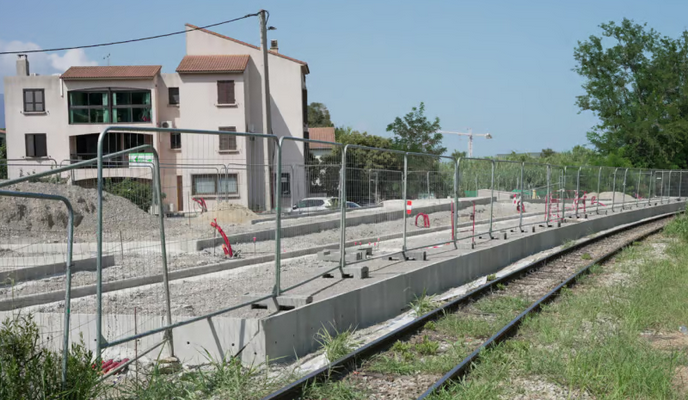
A commission has been set up to take the project forward, starting with introduction of a peak-hour bus service from Folelli and Vescovato to Casamozza station, where the carpark is overflowing and a full-scale rail/bus interchange is planned. Feasibility studies would determine the most cost-effective means of providing rail service from Folelli to Casamozza. Water and other utilities that had made use of the municipally-owned right-of-way have been relocated, while land at the former Orezza-Folelli station, now the town’s mairie, is to be safeguarded for future railway use. Photo: Corse Matin/L-FO.
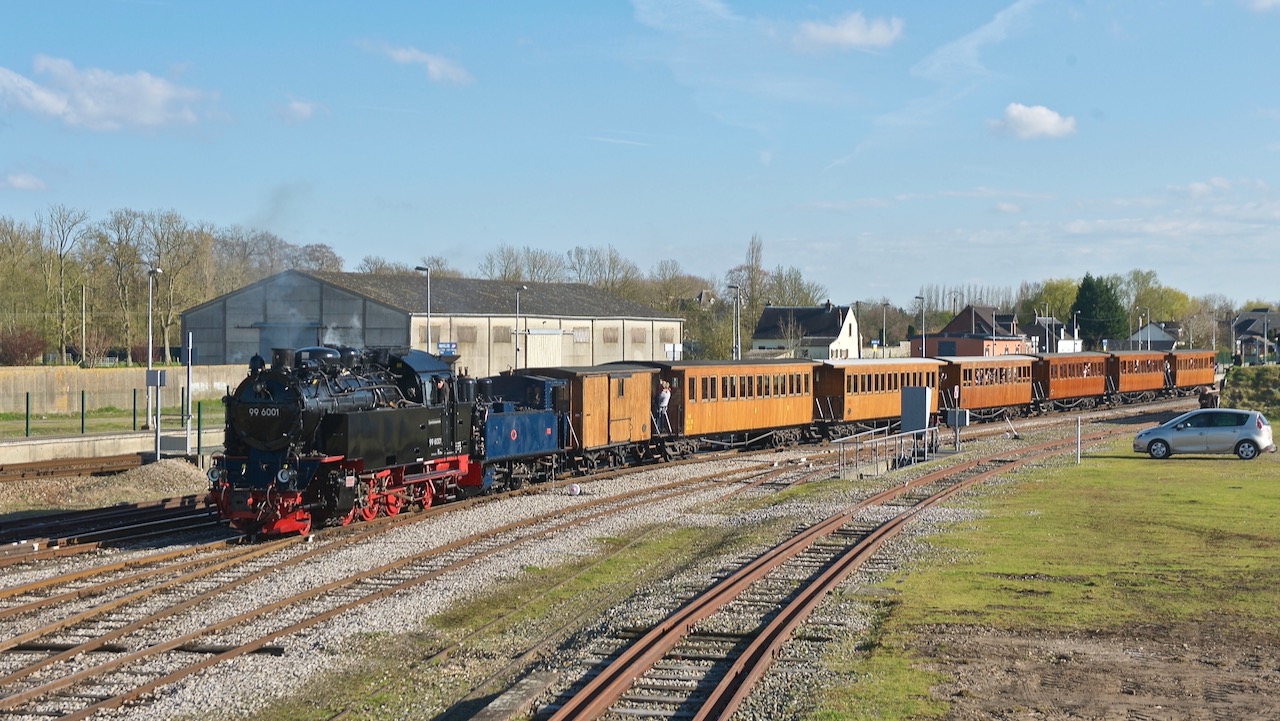
Memories of the 2016 Fête. On 10th April 2016 visiting Harz 030T 99 6001 had undertaken clearance tests between St Valery and Le Crotoy in preparation for the Fête. In the evening it was worked back to St Valery as pilot on the 17.30 from Le Crotoy, seen above departing from Noyelles and dwarfing CFBS Pinguely 101.
CFBS Fête de la Vapeur postponed
CFBS has decided to postpone its Fête de la Vapeur planned to take place over the weekend of 11/13th April 2025 until the same period in 2026. This difficult decision has been made following an assessment of likely costs and other prevailing factors. Mounting a fête requires significant financial outlay, and with income not guaranteed or underwritten represents a major financial risk with breakeven considered a success.
Since the 2021 Fête, costs have increased by more than 10%. Tourism in the Baie de Somme this year has not reached recent high levels due to a combination of poor weather, elections and alternative attractions such as the Olympics. As a result, CFBS has not achieved the cash reserves anticipated, and available resources will be needed for a planned programme of investment over the next three years to maintain the network.
On the locomotive side, in addition to normal winter maintenance, there are some expensive and resource-intensive major repairs needed. New cylinders are required for the Corpet-Louvet; the 031T Buffaud faces major boiler repairs; and restoration of the 030 Piguet is ongoing. Postponement of the 2025 fête will allow this work to be completed and the locomotives run-in, better guaranteeing their availability for a fête in 2026.
Journées européennes du patrimoine
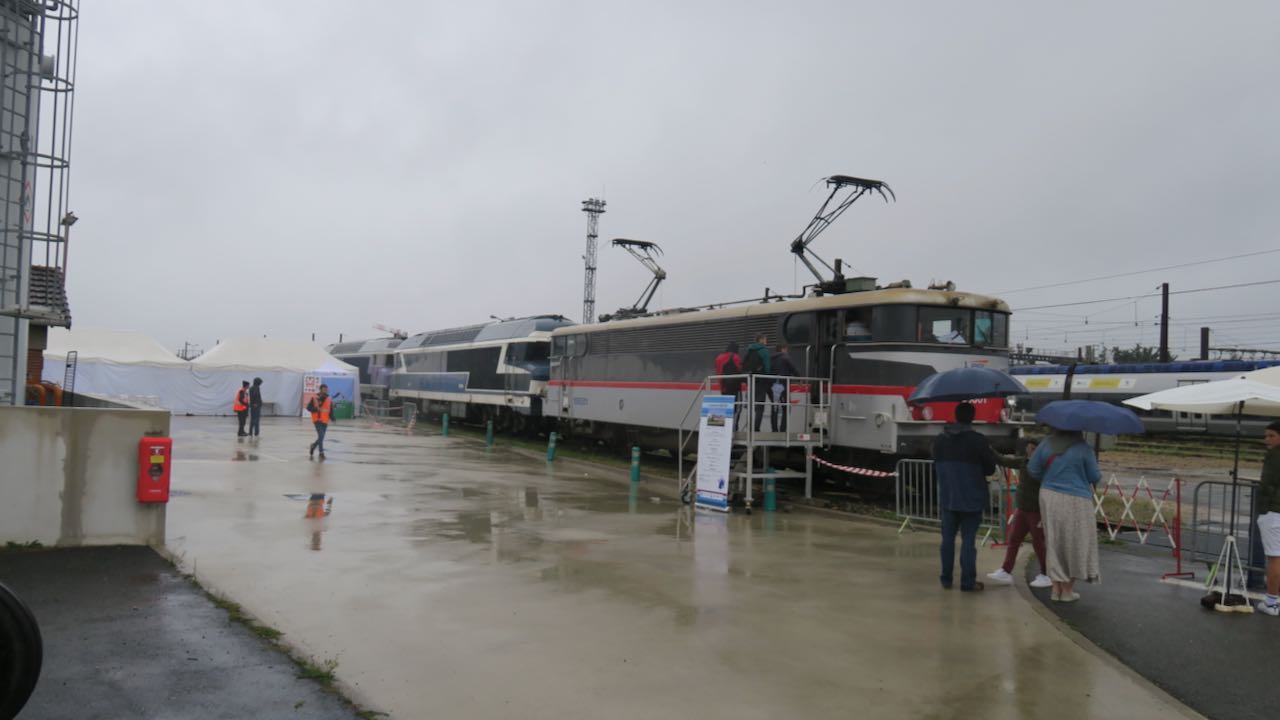
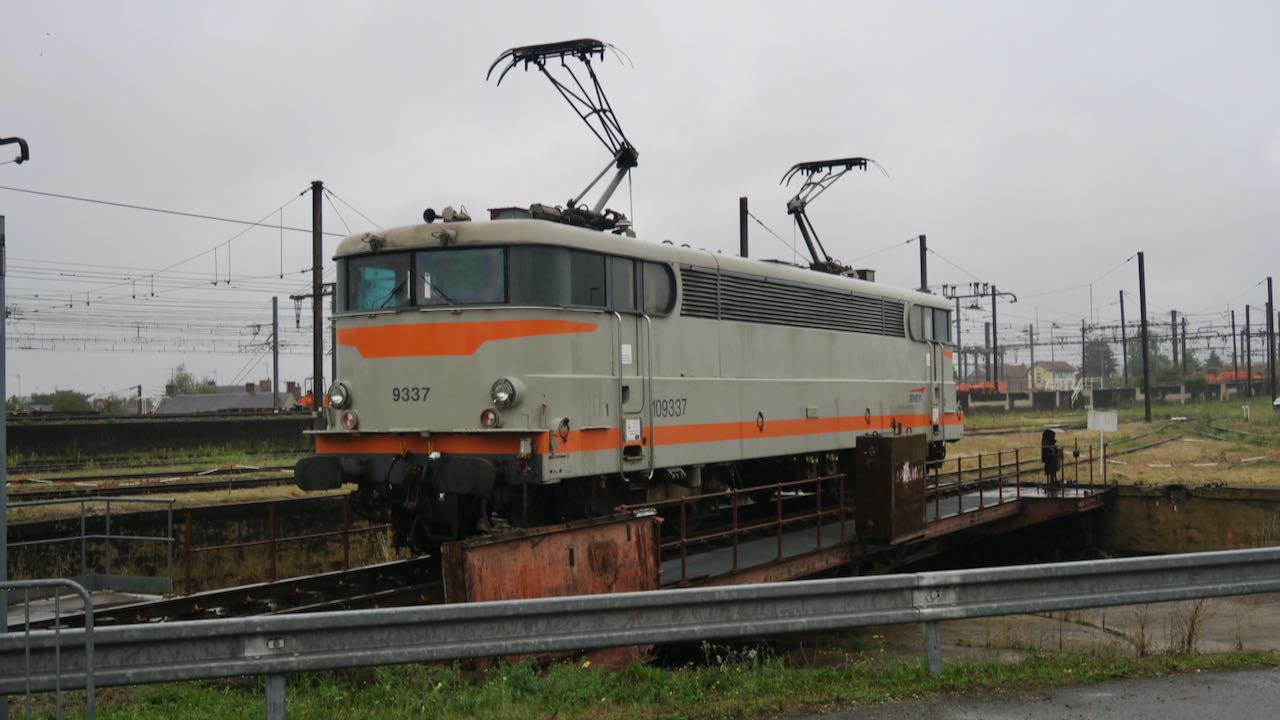
The annual Journées européennes du patrimoine took place over the weekend of the 21st/22nd of September. Numerous events took place at SNCF and preservation locations, although heavy rain at some events discouraged attendance. At Vierzon (above) CFTST (Cercle Ferroviaire des Territoires de Sologne et Touraine) had CC72049/084, BB 8616 and BB 9301/9337 on display, the latter two locomotives are now preserved by APBB9301 and are being temporarily based at Vierzon as there is no accommodation for them at Toulouse.
BB 8616 was also open to the public with the engine room illuminated. (see below). This locomotive has an interesting history. Entering service in January 1974 it was derailed in March 1978 descending the 1 in 25 gradient between Latour-de-Carol and Ax-les-Thermes with a ten coach train. At the time in was operating in multiple with BB 8608 and piloted by BB 4153 because of the train weight. BB 4153 hit a rock fall derailing the train that then proceeded down an embankment with BB 4153 ending up in River Ariège. Recovery of the locomotives was extremely difficult requiring the joint efforts of the St-Pierre-des-Corps 85 tonne crane and a 400 tonne commercial crane set up on the RN 20
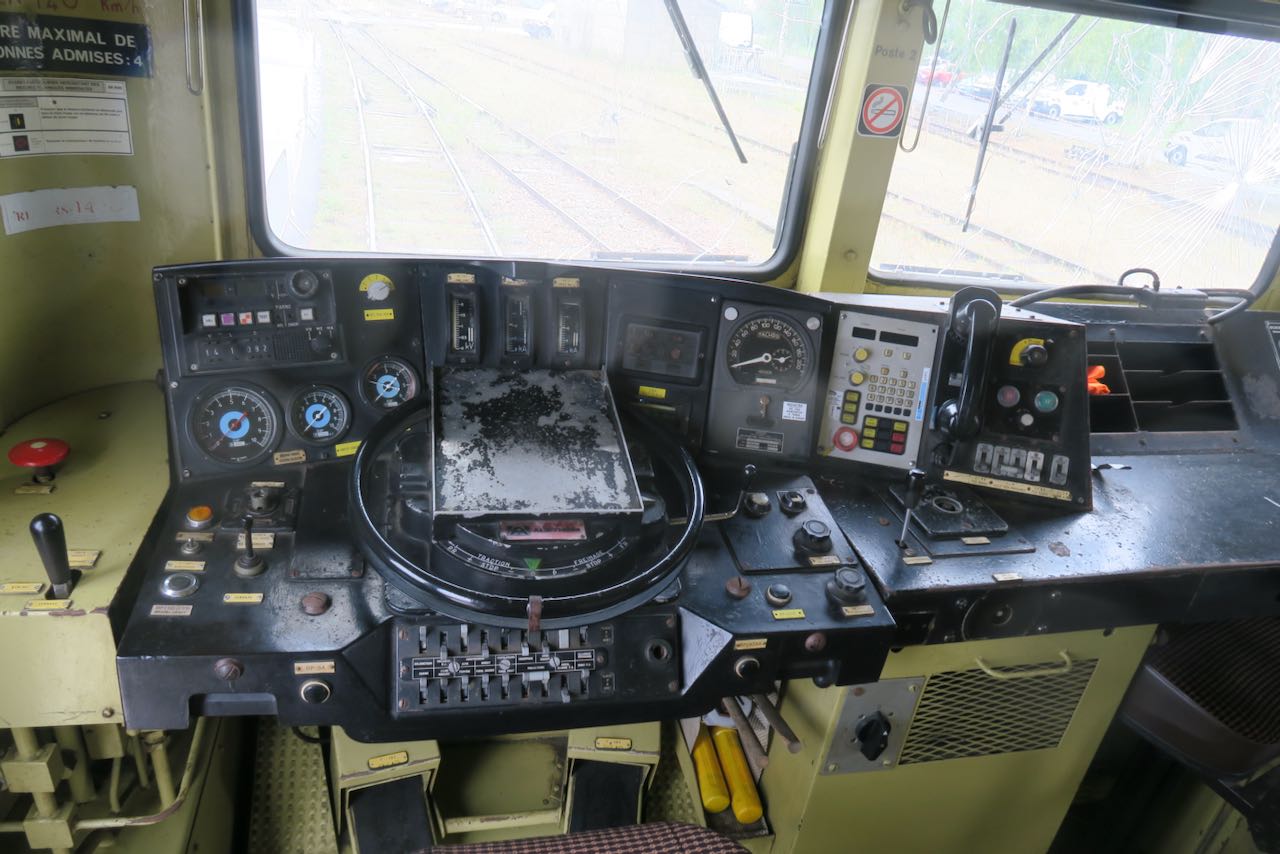
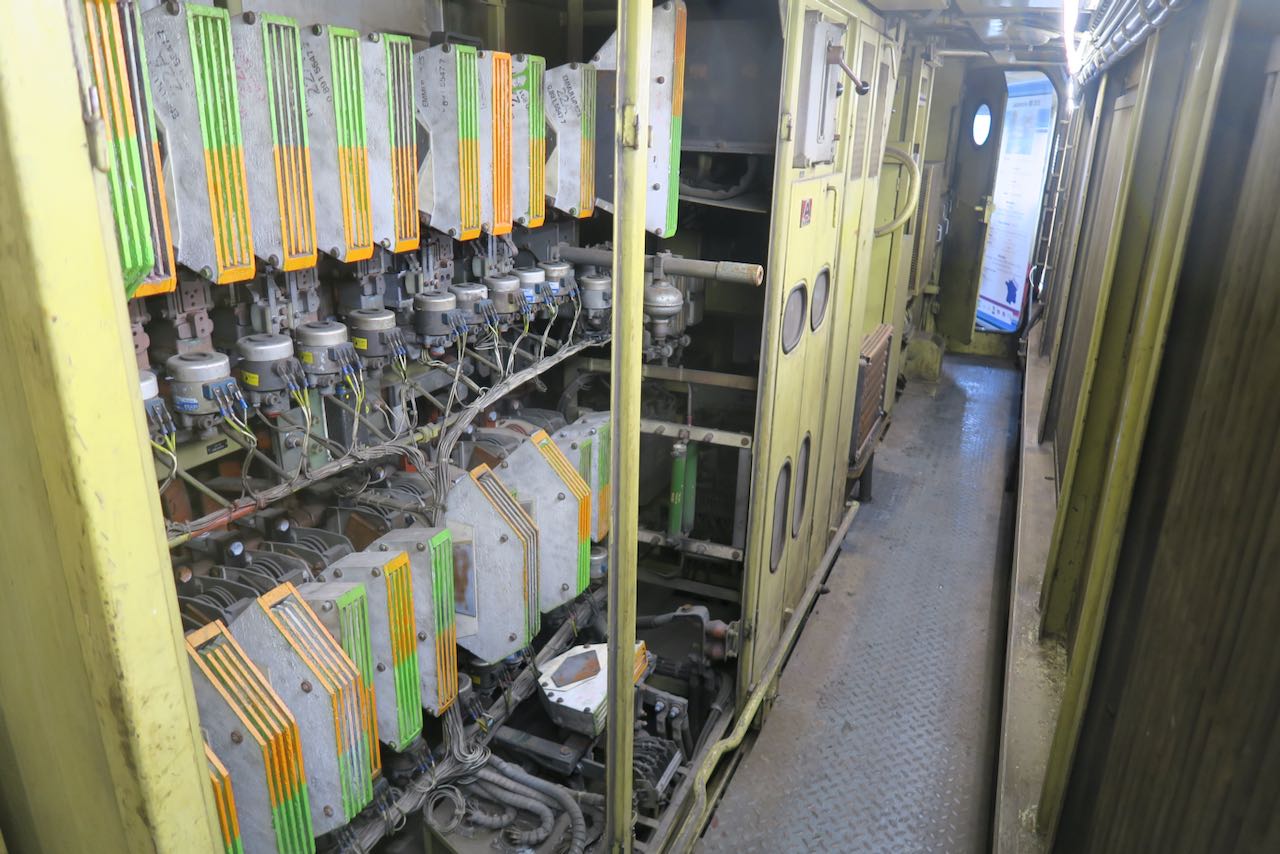
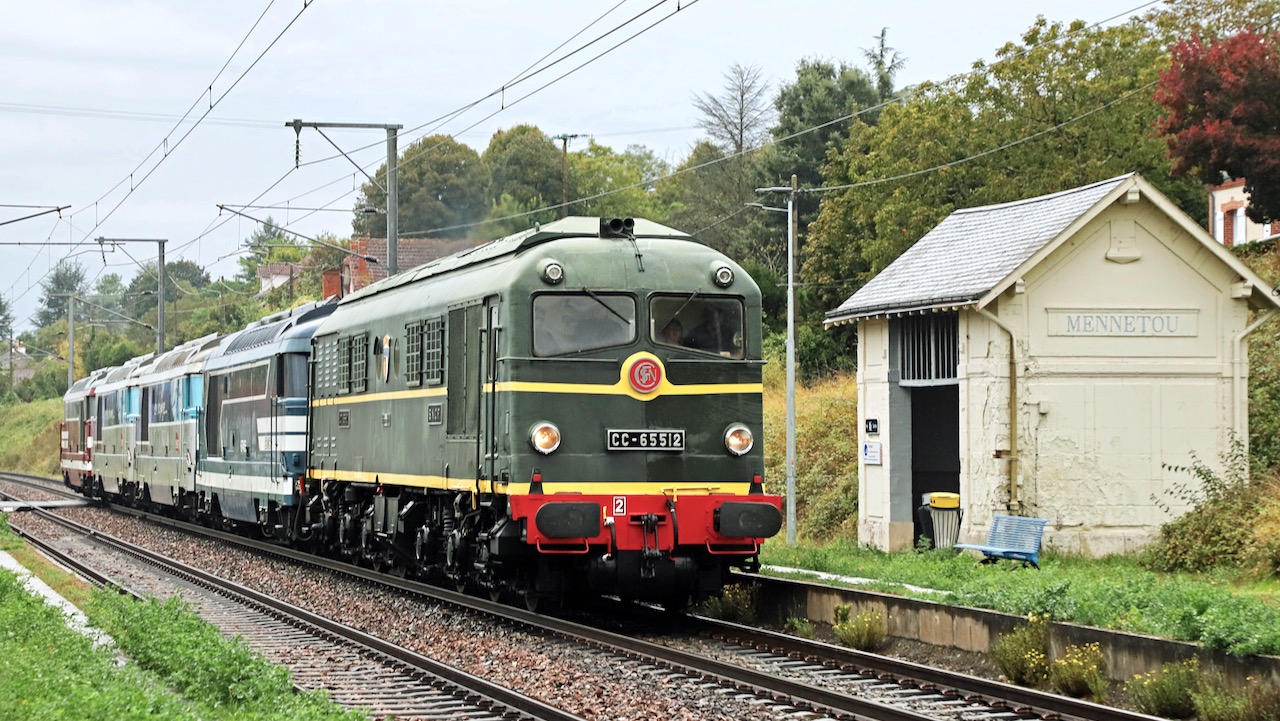
On Sunday 22nd September APPMF organised a test run for CC 65512 from Gièvres to Vierzon and St-Pierre-des-Corps hauling four BB 67400s. The convoy are seen above passing through Mennetou.
AJECTA resumed steam operations with 140 C 231 operating between Longueville and Provins in top and tail mode with BB 67614, seen below on Saturday 21st September. All photos: Jocelyne Bourneuf.
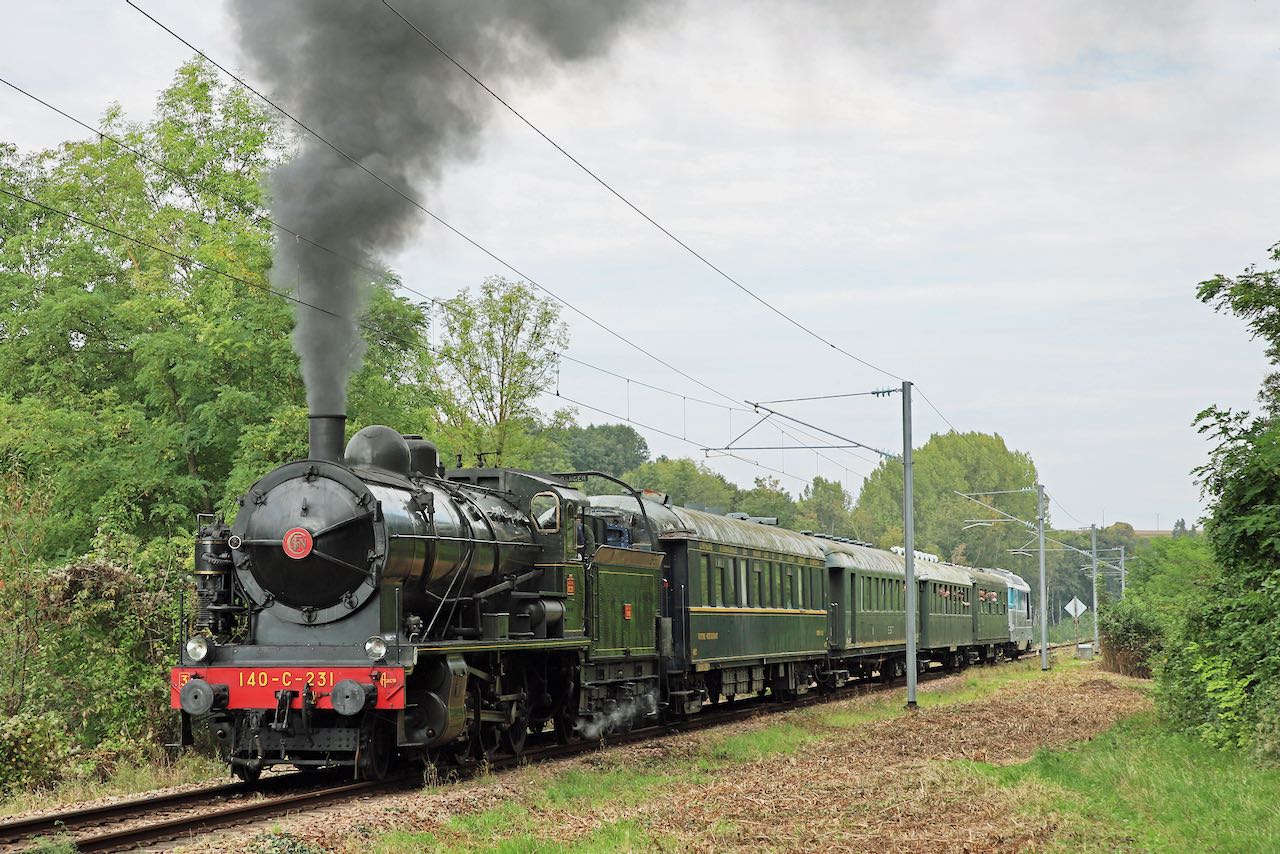

At Toulouse there were no locomotives on display. APBB9301 had hoped to have present BB 9301, but it remained at Vierzon. However, the civil engineering works for the new Metro extensions were open to the public.
The extension of line B from the current terminus of Ramonville to Labège will take the line under the Canal du Midi and the public were able to walk though the new tunnels. Photos: Georges Turpin.
Elsewhere visiters could view the excavations for the new Colomiers gare where there will be three undergraound levels.
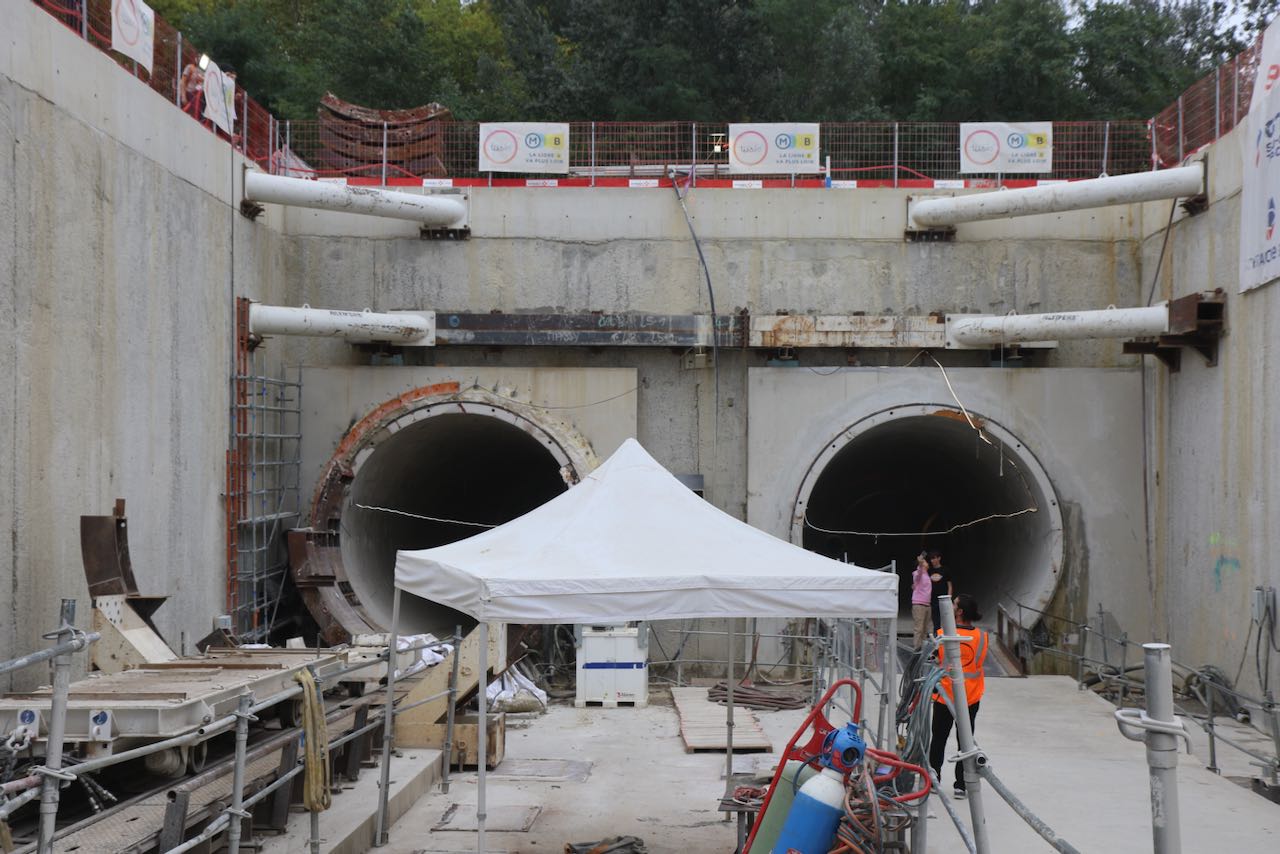
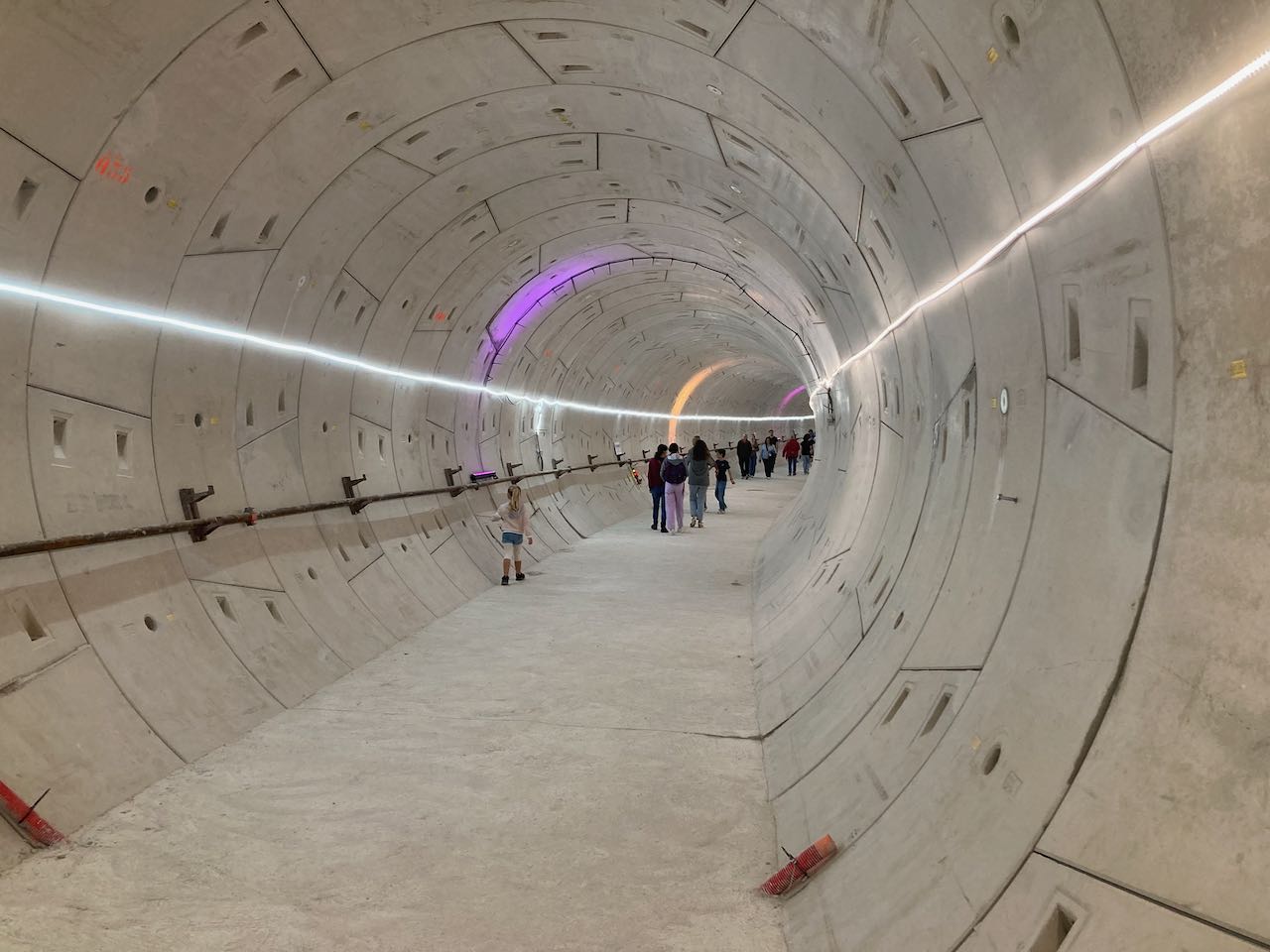
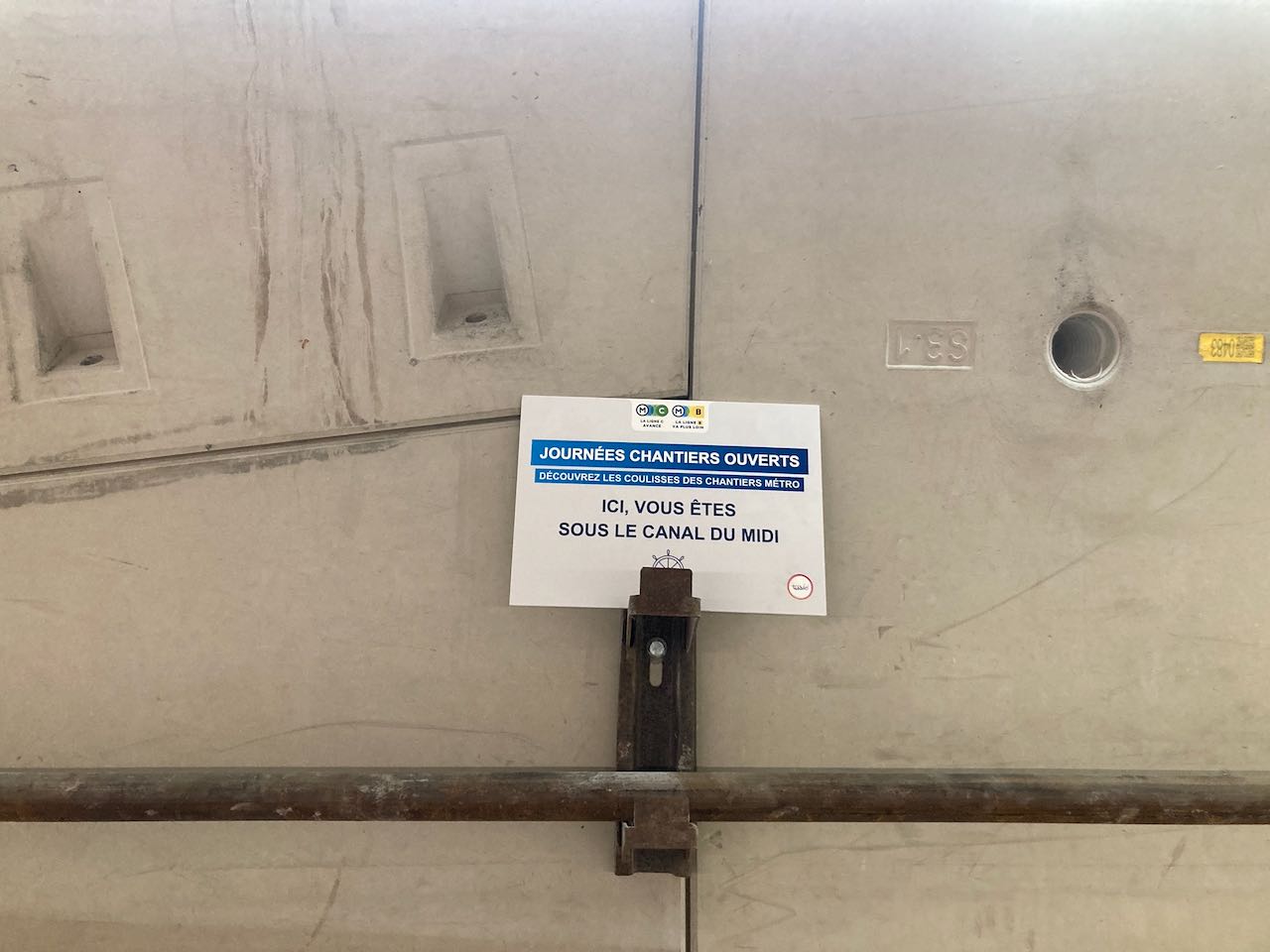

Amongst one of the lesser known sites open over the weekend was the workshop at Saint-Symphorien in Gironde, former nerve centre of the Chemins de Fer Économiques de Gironde. Seven standard-gauge lines once extended 272km linking Mont-de-Marsan in the south with Saint-Symphorien, Facture, Lacanau and Lesparre in the Médoc. Unused since the last line closed in 1978, the workshop contains its original machinery and equipment; though designated a heritage site, finance for its upkeep and preservation has been scarce. Now ownership of the building and its contents have been transferred from the département to the Ville de Saint-Symphorien, which hopes to raise sufficient funds to open the site on a permanent basis.
Above. The exterior with General Motors. 4029 Photo: Georges Turpin.
Opposite. Photo: SudOuest/AD.
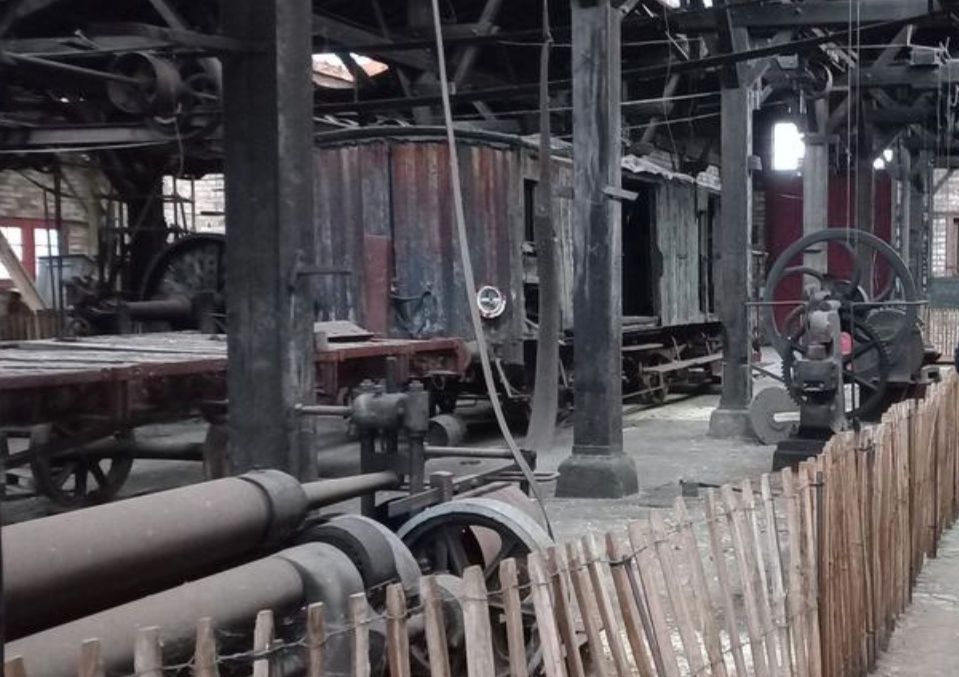

Chemin de fer de la Vendée
The Chemin de fer de la Vendée (CFV) operates between Mortagne-sur-Sèvre and Les Herbiers, once connected to the Nantes –Cholet line. In July Les Herbiers celebrated its 110th anniversary (July 2014), the station soon seeing heavy military traffic. Today, in addition to Sunday steam services the CFV operates a popular dining train three or four times a week during the season with CIWL dining cars 2750 and 4216 and a B3Dt van providing catering and electrical power. Another CIWL vehicle, 4150, is being restored.
The restaurant train is powered by former SNCF Y 7771 repainted in matching dark blue. CFV also have a preserved Picasso autocar available for private charters.
The dining train is seen above shortly after passing Les Epesses on 18th August travelling through Vendée bocage that is typical of much of the route, although it does cross three viaducts that can be seen in CFV's video opposite. Photo: Georges Turpin.
The line is owned by the Department and is subject to proposals for re-opening to serve the adjacent parc du Puy du Fou for which the Government made €20 million available last year (see January News).
The line is owned by the Department and is subject to proposals for re-opening to serve the adjacent parc du Puy du Fou for which the Government made €20 million available last year (see January News).
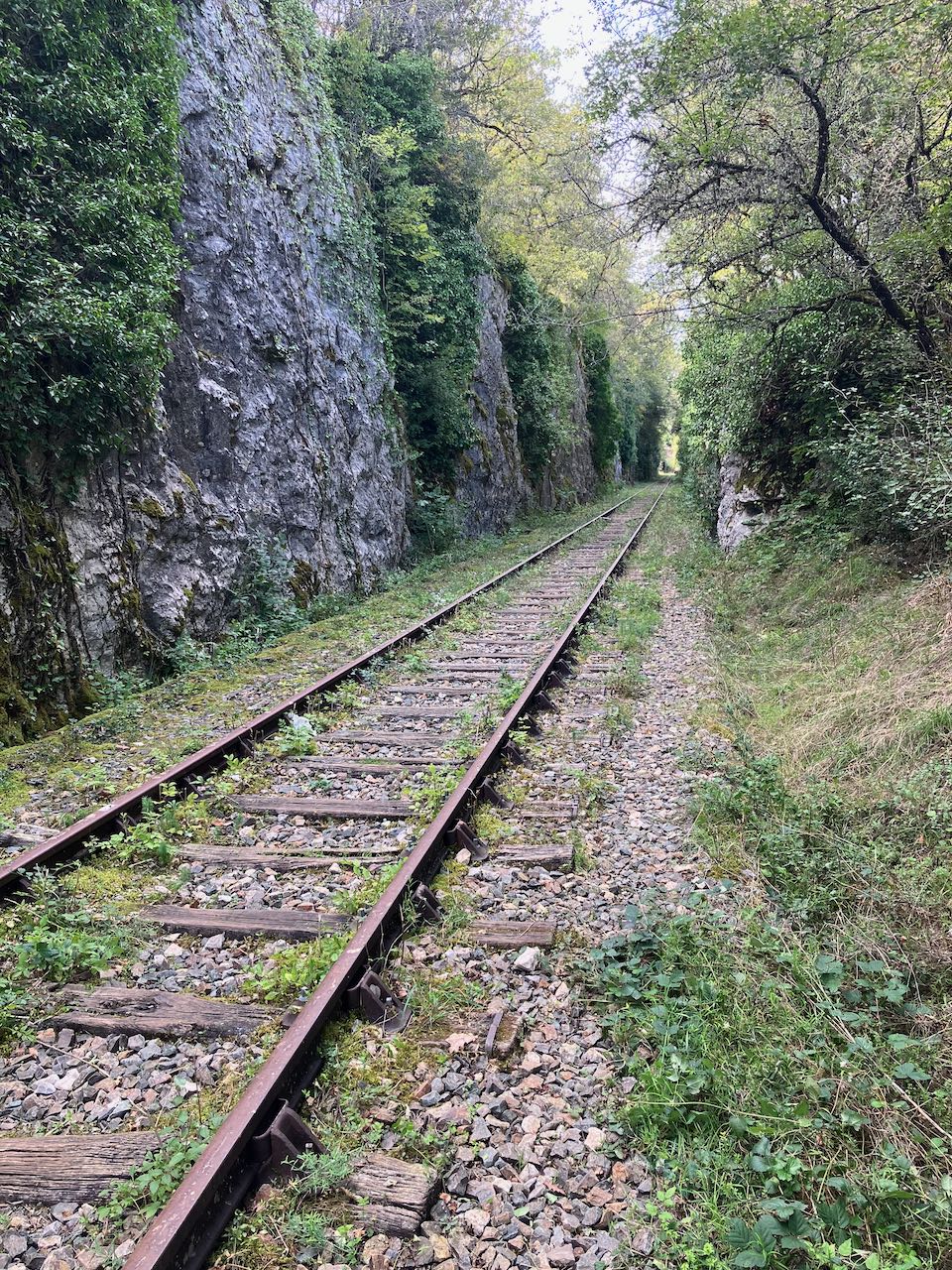
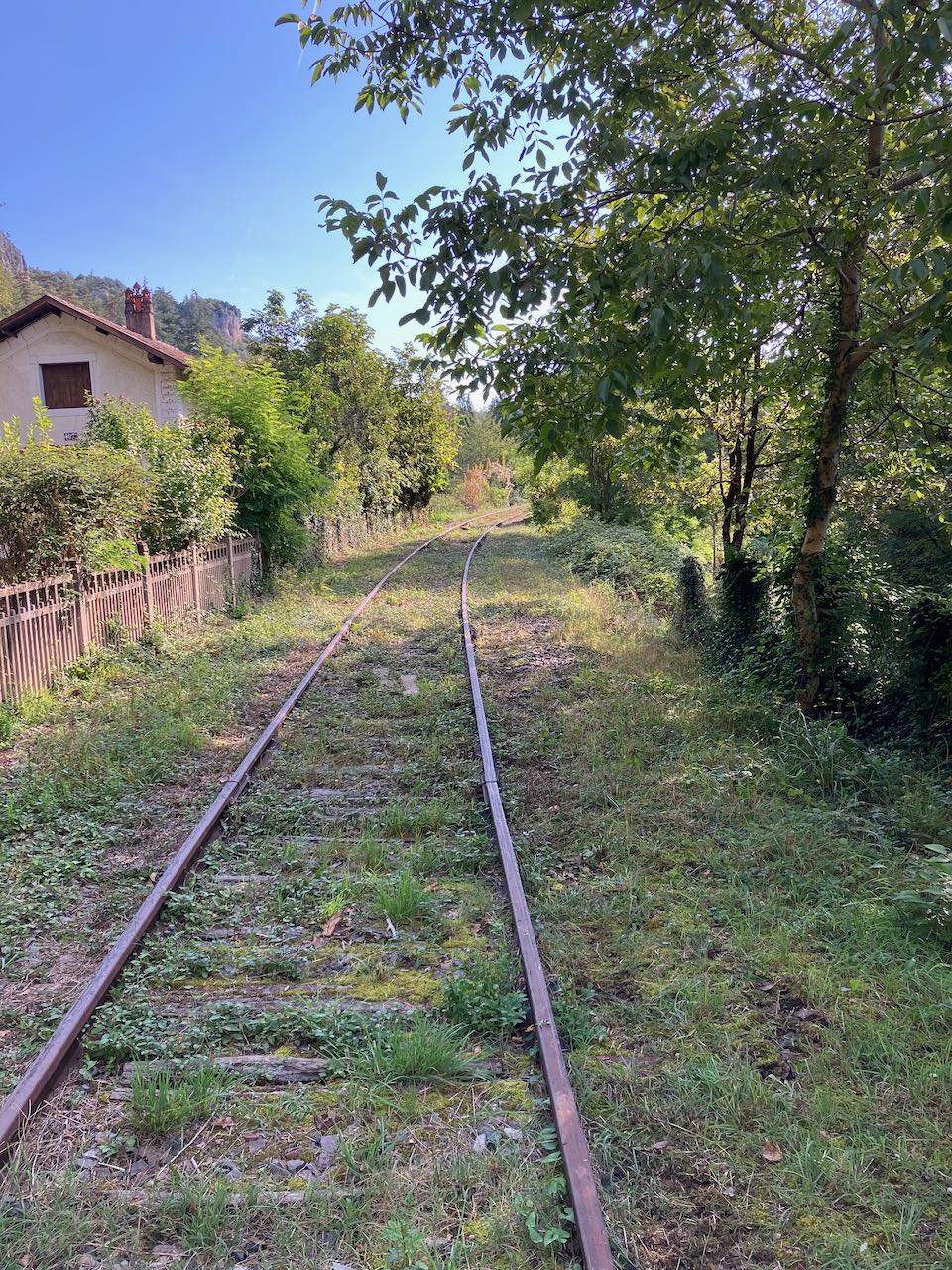
Lot Valley Voie Verte
Work is underway on developing the Lot Valley Voie Verte utilising the trackbed of the former Cahors – Monsempron-Libos and Cahors – Capdenac lines. When completed the Voie Verte will run from Capdenac to Soturac, near Fumel. West of Cahors the track of the former Monsempron-Libos line was lifted some years ago and the section from Douelle to the former junction near Mercuès has been completed, with land acquired to continue to the edge of Cahors. In Cahors discussions are still underway on determining the route through the town and across the Lot to link up with the former Capdenac line.
On the section from Cahors to Capdenac the track is still largely in place, apart from around Cajarc where it was lifted at the end of 2023, leaving a few short sections around the Musée du Rail and Quercyrail's Picasso (X3825). The last trains to operate between Cahors and Capdenac were the Quercyrail tourist trains that last ran in 2003. Since then vegetation and trees have taken over. This has now all been cleared in readiness for lifting the track, presenting a somewhat surreal aspect, as if the line is about to re-open. The photos above show the position at Bouzies (left) and near St-Cirq-Lapopie (right) on the 16th September.
Metro pour tous
Noting that all Paralympics venues were served by accessible vehicles and stations, Mme Pécresse said “the historic metro network remains the black spot. Within Paris buses are 100% accessible, but only 25% of the rail network”. That situation was highlighted on the opening day (28th August) when Pierrick Courilleau, an elected official of Orsay commune in Essonne and wheelchair user, arrived in Paris too late to watch the passage of the Olympic Flame because no staff were available to help him board RER Line B at Le Guichet station.
The long-discussed project would be extremely expensive and take at least 20 years to achieve, Mme Pécresse said; even then there would be some metro stations where 100% accessibility would be impossible on technical grounds. Cost estimates are based on a study of Line 6 which is partly elevated and therefore likely to be less expensive than all-tunnel, between €600 and €800 million. For the entire network of 13 lines with 320 stations (9% already accessible), the estimate is between €15 and €20 billion, though detailed studies for provision of lifts and level platforms have yet to be made for individual stations.
Mme Pécresse put forward a financing plan that split the cost equally between the State, ÎdeF région and Ville de Paris. Commentators were sceptical. FNAUT was in favour of incremental improvements but doubted that 100% accessibility could be achieved. It felt that a wide-scale plan was ‘utopian’ and questioned whether such huge investment would be to the detriment of other projects.
Representatives of blind and partially-sighted persons pointed to the already lengthy process of simply fitting metro trains with automated announcements, currently absent on seven lines. Line 6 trains should be so-equipped by the end of 2026, Line 10 work should start next year, but Line 7 trains must wait almost 10 years. Nevertheless, Association APF France Handicap immediately invited ÎdeFM and other stakeholders to discuss the plans, resulting in the 5th September agreement.
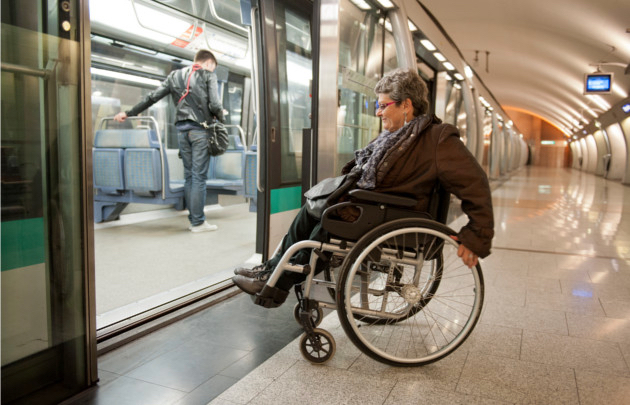
Line 14 is the only fully-accessible metro running through central Paris. Photo: ©Paris je t’aime.
Paris flat fare. In a simplification of tariffs and abolition of fare zones from 2nd January 2025, Île-de-France Mobilités is introducing a €2.50 flat fare for occasional users (ie non-passholders) for journeys by metro, RER and suburban trains regardless of distance, with a bus and tram only version at €2. For residents, the Pass Liberté will now be valid throughout Île-de-France with rail journeys at €1.99 and bus/tram journeys at €1.60. The NavigoJour ticket widely used by tourists will be €12, replacing fare bands from €8.30 to €20.60.
Grenoble. From 2nd September the area’s two public transport networks M’Tag (city) and M’TouGo (regional) were merged under the M’Réso brand with unified fares and ticketing. All transport was fares-free on that day to mark the change.
Metro maintenance. RATP has selected TSO to carry out routine maintenance and track renewal on the metro network (excluding GPE) under eight-year framework contracts starting in 2028. TSO will use a battery-powered factory train developed by Scheuchzer SA for renewal work, and two battery-electric tamping machines from Plasser & Theurer. These MetroFlex E³ machines are customised for use on rubber-tyred metro lines, taking power from the conductor rail and from an onboard battery when traction power is switched off.
Saint-Étienne. An open payments system has been implemented, with 300 validators installed on trams and buses, to be extended next year enabling interoperability with the Oùra regional contactless card. STAS carried 42.5 million passengers in 2023, an increase of 9.3 per cent.
Rennes. At a press conference on 28th August, Métropole and Keolis Rennes officials reported that Line B had performed well ‘with no major incident’ since reopening on 20th June. All trains are back in service except for the one damaged in the major failure in January, still stopped due to spare parts shortage.The trains remain under daily supervision, with detailed checks every 5,000km and full maintenance at 30,000km.
Strasbourg. The first track of Tram Ouest, the 4km extension of Line F, was laid by the maire of Strasbourg at Wolfisheim on 26th August. The new section with eight stops will open late next year. Public consultation started on 9th September for Tram Nord, the proposed 5km extension with nine stops to Schiltigheim and Bischheim expected to open in 2027.
A six-week trial until 26th October is assessing the feasibility of using trams to move parcels around the city without affecting operations, passenger comfort or parcel delivery schedules. The loads are carried twice daily on Line B between Hœnheim Gare and Broglie. Photo: Strasbourg.eu/Elyxandro Cegarra.
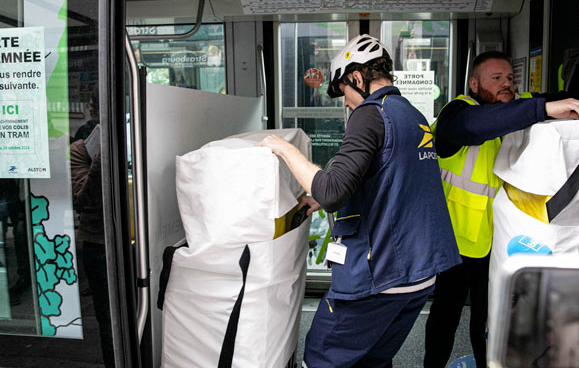
Lille. Problems caused by the discovery of asbestos in the Line 2 workshops worsened with the start of the new school year. Lille’s maire called for passengers to be recompensed but operator Ilévia said that train frequency would improve over the coming weeks. As a compensatory gesture, the Métropole proposed free access for metro passengers to the city’s V’lille cycle scheme.
Aubagne. Métropole Aix-Marseille-Provence has ordered a further four cars from Alstom for the 14.4km Val’Tram line under construction between Aubagne and La Bouilladisse. Opening next year, the tramway utilises the trackbed of the former PLM line from Aubagne to La Barque which served the Houillères de Provence coal mines until closure in 1972.
Additions to FRS Photographic Archive during August & September 2024
To Photographic section
- A few photographs of the PO serie 4700/SNCF 240A, SNCF BB.0401 (prototype for BB.8100 series) & BB.8105 have been added to the Jean-Hugo Filiette gallery in Folder 1
- A few diagrams of electric locomotives and Exterior Painting Instructions for the Serie BB.8100 have been added to the Jean-Hugo Filliette gallery in Folder 2
- FACS Magazine no 418 - July-August 2023 to Folder 12
- Schneider-Creusot - Locomotive Technical Data & Diagrammes (1838/1875) have been added to Folder 7 “Miscellaneous” under “Locomotive & Rolling Stock builders”
Nil
Additions to the FRS public folder during August & September 2024
- Combined library lists of SLS & FRS
- PO Midi Painting Instructions for locomotives and rolling stock - December 1937
- Locomotive Exhibits @ Paris Int’l Expo 1900
- Chaix Annuaire Officiel des Chemins de Fer (1849-1850-1851)
- JEP models catalogues (1953/1954, 1957/1958, 1959 & 1961)

© Peter Lovell & Chris Bushell. The French Railways Society 2024. With thanks to Georges Turpin, Christophe Masse, Jocelyne Bourneuf, David Haydock, Pete Brendon, John Bamforth and Phil Richards.
